Paul van Yperen's Blog, page 332
September 29, 2016
Johnny Kraaykamp
Today is the final day of the Netherlands Film Festival (NFF), and also of EFSP's Unofficial Netherlands Film Postcard Festival (UNFPF). Today's star is John Kraaykamp, Sr. (1925–2011), one of The Netherlands' most popular comedians, praised for his perfect timing. For years, he formed a comedy team with Rijk de Gooyer as Johnny & Rijk. He also played in more serious plays and films, including the Academy Award winning WW II film drama De aanslag/The Assault (1986).
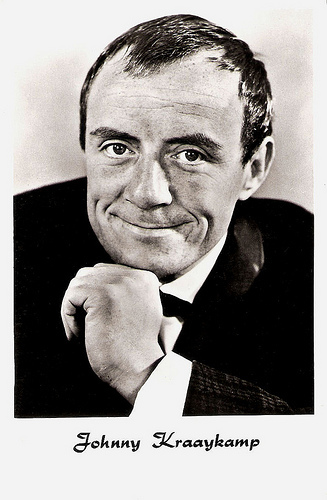
Dutch card.
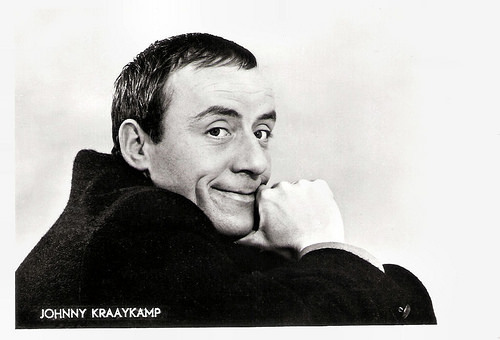
Dutch card by Anova, Amsterdam.
Boy Soprano
Johnny Kraaykamp (also written as Kraaijkamp) was born as Jan Hendrik Kraaijkamp in Amsterdam, The Netherlands in 1925. He was one of four children of a greengrocer and a house cleaner. He grew up in the Kinkerbuurt in Amsterdam. After an accident, his father was declared unfit for work and Johnny had to find work at a young age.
At 14, he already performed as a boy soprano in the famous Amsterdam theatre Carré. He worked for a short while as an acrobat, but then moved on to become a singer in a show orchestra. He performed as an entertainer and bass player in local bars, where he was discovered in the 1950s by Rijk de Gooyer .
Together they recorded the song Twee jongens op een gitaar (Two guys on a guitar). It was the start of a long and successful partnership. Johnny and Rijk began to perform together on radio and television. In spring 1956, they joined the Weekendshow, a popular entertainment show on the Dutch radio. They also toured with the Snip & Snap Revue and performed in several comedy plays written for TV, together and apart.
In 1962, they got together again for Open het dorp (Open the village), an extremely well-watched TV benefit marathon presented by Mies Bouwman, in which they performed in their pyjamas. In the 1960s and 1970s they performed regularly together on Dutch TV. In 1964, they began with the Johnny & Rijk shows. In their shows, Rijk was the ‘feeder’ and John the comedian. The duo also recorded a couple of hit singles, including De Bostella (The Bostella), for which they received a golden record in 1968. They even had a show on German TV, Spass durch Zwei/Fun By Two (Bob Rooijens, 1970-1971).
Johnny also appeared in several Dutch films, including Daniël (Erik Terpstra, 1971), Geen paniek/No Panic (Ko Koedijk, 1973) with Rijk de Gooyer , De vijf van de vierdaagse/The Five Are Marching In (René van Nie, 1974), Heb medelij Jet/Happy Days Are Here Again (Frans Weisz, 1975), Zwaarmoedige verhalen voor bij de centrale verwarming/Melancholy Tales (Nouchka van Brakel a.o., 1975) and the anthology film Vroeger kon je lachen/One Could Laugh in Former Days (Bert Haanstra, 1983), with adaptations of ironic newspaper-columns by the Dutch author Simon Carmiggelt. In Germany Kraaykamp appeared in the sex comedy Die Stoßburg/The Sex Castle (Franz Marischka, 1974) and in Belgium in the drama Verbrande brug/Burned Bridges (Guido Henderickx, 1975) with Yves Beneyton.
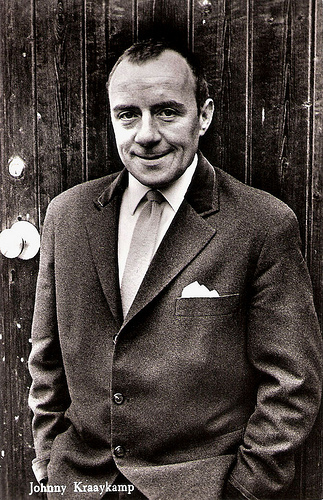
Dutch postcard by Gebr. Spanjersberg N.V., Rotterdam, no. 1109. Photo: Artone.
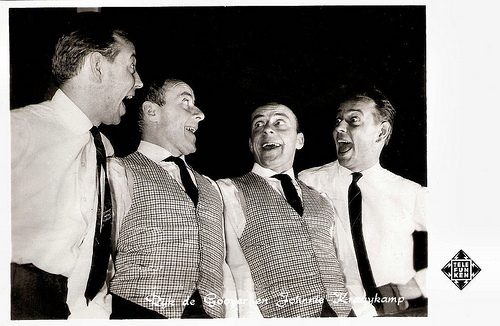
Johnny Kraaykamp and Rijk de Gooijer. Dutch postcard by Editions Altona, Amsterdam / Gebr. Spanjersberg, Rotterdam. Photo: Telefunken.
Pig-headed Old Man
In 1973, John Kraaykamp made a couple of TV shows without Rijk de Gooyer , but with Tonny Huurdeman as his new feeder. De Gooyer had started a successful film career. Unfortunately, these shows were not very successful: the show only lasted three episodes. Later a series of Johnny Kraaykamp Shows was more successful. In 1985, he joined old partner De Gooyer in the TV series De Brekers/The Brekers (Rob Herzet, 1985-1988), which co-starred Adèle Bloemendaal.
Kraaykamp also played in a couple of prestigious films in the 1980s, including De Wisselwachter/The Pointsman (Jos Stelling, 1986) and Iris (Mady Saks, 1987), with Monique van de Ven. His most successful film was De aanslag/The Assault (Fons Rademakers, 1986), in which he played an old resistance fighter opposite Derek de Lint.
Kraaykamp also was a prolific stage actor. With theatre company Ensemble he played in The Taming of the Shrew from 1958 to 1959. From 1962 to 1964 he was a member of the Amsterdams Volkstoneel. He also starred in a couple of musicals, including Irma la Douce (1962–1964) and Man of La Mancha (1969–1970).
After a period of comic plays, he joined the Ro Theater in 1979 to play in a number of classic roles. The title role in William Shakespeare's King Lear that year is considered his big breakthrough as a serious actor. He also performed in A Midsummer Night's Dream. In 1984 he won the Louis d'Or, the most prestigious award in stage acting in The Netherlands, for his lead role in Denis Diderot's Jacques de fatalist en zijn meester (Jack, the fatalist and his master).
From 1988 on, he starred on TV in the prison sitcom Laat maar zitten/Leave Them in Jail (John van de Rest, 1988-1991), based on the British TV series Porridge. His most successful role in later years was the part of Piet Boverkerk in the comedy series Het zonnetje in huis/Sunshine at Home (Hans de Korte, 1993-2003). In the show, he played a pig-headed old man that comes to live with his son and daughter-in-law (played by his own son, John Kraaijkamp, Jr, and Martine Bijl) after his wife passed away. The show was a remake of the British sitcom Tom, Dick and Harriet, created by Cooke and Mortimer.
Kraaykamp's last film was the successful child drama Kruimeltje/Little Crumb (Maria Peters, 1999) featuring Ruud Feltkamp. John Kraaijkamp died in 2011 in Laren. He was 86. Kraaijkamp was married three times and had four children. With Riemada Elisabeth Panhuysen, he had two children, son John (1954) and daughter Ellissigne. With his second wife, Tilly van Duijkeren, he had a son, Michiel. With Mai Lun Lee he had a daughter, Sanne. John, Ellissigne and Sanne became actors. Throughout his life, Kraaykamp received several acting awards. Besides the Louis d'Or in 1984, he received the Golden Calf (the Dutch Oscar) in 1986 for his roles in the films De aanslag/The Assault and De Wisselwachter.
Johnny & Rijk sing De Bostella. Source: TopPop (YouTube).
American trailer for De aanslag/The Assault. Source: The Best Foreign Movies (YouTube).
Sources: Beeld en Geluid (Dutch), Wikipedia (Dutch) and .

Dutch card.

Dutch card by Anova, Amsterdam.
Boy Soprano
Johnny Kraaykamp (also written as Kraaijkamp) was born as Jan Hendrik Kraaijkamp in Amsterdam, The Netherlands in 1925. He was one of four children of a greengrocer and a house cleaner. He grew up in the Kinkerbuurt in Amsterdam. After an accident, his father was declared unfit for work and Johnny had to find work at a young age.
At 14, he already performed as a boy soprano in the famous Amsterdam theatre Carré. He worked for a short while as an acrobat, but then moved on to become a singer in a show orchestra. He performed as an entertainer and bass player in local bars, where he was discovered in the 1950s by Rijk de Gooyer .
Together they recorded the song Twee jongens op een gitaar (Two guys on a guitar). It was the start of a long and successful partnership. Johnny and Rijk began to perform together on radio and television. In spring 1956, they joined the Weekendshow, a popular entertainment show on the Dutch radio. They also toured with the Snip & Snap Revue and performed in several comedy plays written for TV, together and apart.
In 1962, they got together again for Open het dorp (Open the village), an extremely well-watched TV benefit marathon presented by Mies Bouwman, in which they performed in their pyjamas. In the 1960s and 1970s they performed regularly together on Dutch TV. In 1964, they began with the Johnny & Rijk shows. In their shows, Rijk was the ‘feeder’ and John the comedian. The duo also recorded a couple of hit singles, including De Bostella (The Bostella), for which they received a golden record in 1968. They even had a show on German TV, Spass durch Zwei/Fun By Two (Bob Rooijens, 1970-1971).
Johnny also appeared in several Dutch films, including Daniël (Erik Terpstra, 1971), Geen paniek/No Panic (Ko Koedijk, 1973) with Rijk de Gooyer , De vijf van de vierdaagse/The Five Are Marching In (René van Nie, 1974), Heb medelij Jet/Happy Days Are Here Again (Frans Weisz, 1975), Zwaarmoedige verhalen voor bij de centrale verwarming/Melancholy Tales (Nouchka van Brakel a.o., 1975) and the anthology film Vroeger kon je lachen/One Could Laugh in Former Days (Bert Haanstra, 1983), with adaptations of ironic newspaper-columns by the Dutch author Simon Carmiggelt. In Germany Kraaykamp appeared in the sex comedy Die Stoßburg/The Sex Castle (Franz Marischka, 1974) and in Belgium in the drama Verbrande brug/Burned Bridges (Guido Henderickx, 1975) with Yves Beneyton.

Dutch postcard by Gebr. Spanjersberg N.V., Rotterdam, no. 1109. Photo: Artone.

Johnny Kraaykamp and Rijk de Gooijer. Dutch postcard by Editions Altona, Amsterdam / Gebr. Spanjersberg, Rotterdam. Photo: Telefunken.
Pig-headed Old Man
In 1973, John Kraaykamp made a couple of TV shows without Rijk de Gooyer , but with Tonny Huurdeman as his new feeder. De Gooyer had started a successful film career. Unfortunately, these shows were not very successful: the show only lasted three episodes. Later a series of Johnny Kraaykamp Shows was more successful. In 1985, he joined old partner De Gooyer in the TV series De Brekers/The Brekers (Rob Herzet, 1985-1988), which co-starred Adèle Bloemendaal.
Kraaykamp also played in a couple of prestigious films in the 1980s, including De Wisselwachter/The Pointsman (Jos Stelling, 1986) and Iris (Mady Saks, 1987), with Monique van de Ven. His most successful film was De aanslag/The Assault (Fons Rademakers, 1986), in which he played an old resistance fighter opposite Derek de Lint.
Kraaykamp also was a prolific stage actor. With theatre company Ensemble he played in The Taming of the Shrew from 1958 to 1959. From 1962 to 1964 he was a member of the Amsterdams Volkstoneel. He also starred in a couple of musicals, including Irma la Douce (1962–1964) and Man of La Mancha (1969–1970).
After a period of comic plays, he joined the Ro Theater in 1979 to play in a number of classic roles. The title role in William Shakespeare's King Lear that year is considered his big breakthrough as a serious actor. He also performed in A Midsummer Night's Dream. In 1984 he won the Louis d'Or, the most prestigious award in stage acting in The Netherlands, for his lead role in Denis Diderot's Jacques de fatalist en zijn meester (Jack, the fatalist and his master).
From 1988 on, he starred on TV in the prison sitcom Laat maar zitten/Leave Them in Jail (John van de Rest, 1988-1991), based on the British TV series Porridge. His most successful role in later years was the part of Piet Boverkerk in the comedy series Het zonnetje in huis/Sunshine at Home (Hans de Korte, 1993-2003). In the show, he played a pig-headed old man that comes to live with his son and daughter-in-law (played by his own son, John Kraaijkamp, Jr, and Martine Bijl) after his wife passed away. The show was a remake of the British sitcom Tom, Dick and Harriet, created by Cooke and Mortimer.
Kraaykamp's last film was the successful child drama Kruimeltje/Little Crumb (Maria Peters, 1999) featuring Ruud Feltkamp. John Kraaijkamp died in 2011 in Laren. He was 86. Kraaijkamp was married three times and had four children. With Riemada Elisabeth Panhuysen, he had two children, son John (1954) and daughter Ellissigne. With his second wife, Tilly van Duijkeren, he had a son, Michiel. With Mai Lun Lee he had a daughter, Sanne. John, Ellissigne and Sanne became actors. Throughout his life, Kraaykamp received several acting awards. Besides the Louis d'Or in 1984, he received the Golden Calf (the Dutch Oscar) in 1986 for his roles in the films De aanslag/The Assault and De Wisselwachter.
Johnny & Rijk sing De Bostella. Source: TopPop (YouTube).
American trailer for De aanslag/The Assault. Source: The Best Foreign Movies (YouTube).
Sources: Beeld en Geluid (Dutch), Wikipedia (Dutch) and .
Published on September 29, 2016 22:00
September 28, 2016
Lien Deyers
During the Netherlands Film Festival, EFSP presents the traditional Unofficial Dutch Film Star Postcards Festival. Today's post is about Lien Deyers (1910-1965?). She was discovered by famous director Fritz Lang who gave her a part in Spione/Spies (1928). During eight years, she acted in 32 late silent and early sound films. After 1935 her star faded rapidly and her life ended in tragedy.
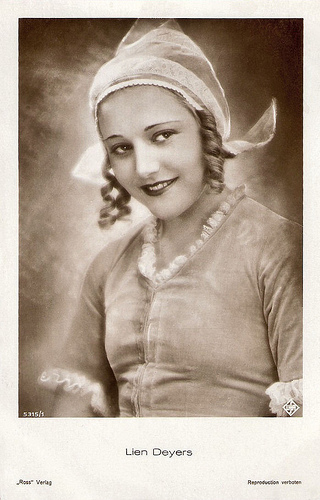
German postcard by Ross Verlag, no. 5315/1, 1930-1931 Photo: Ufa. Collection: Geoffrey Donaldson Institute.
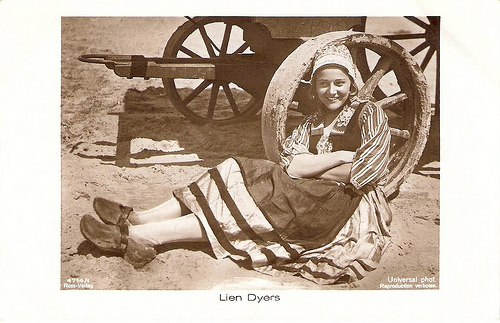
German postcard by Ross Verlag, no. 4714/1, 1929-1930. Photo: Universal.
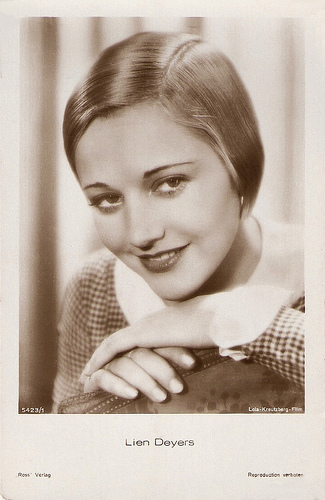
German postcard by Ross Verlag, no. 5423/1, 1930-1931. Photo: Lola-Kreutzberg-Film.
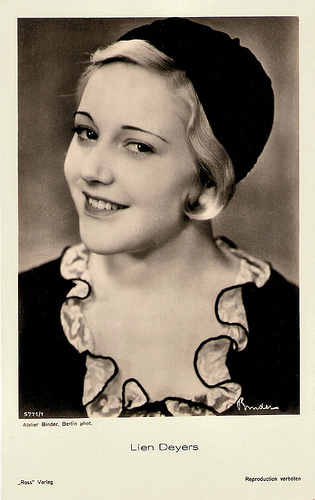
German postcard by Ross Verlag, no. 5771/1, 1930-1931. Photo: Alex Binder.
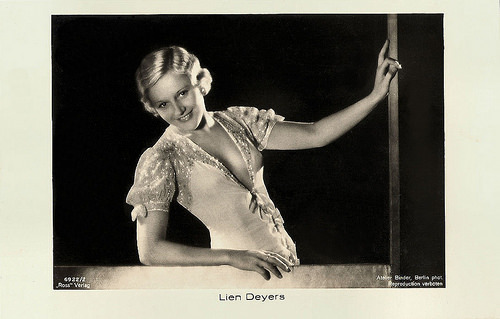
German postcard by Ross-Verlag, no. 6922/2, 1931-1932. Photo: Atelier Binder. Collection: Geoffrey Donaldson Institute.
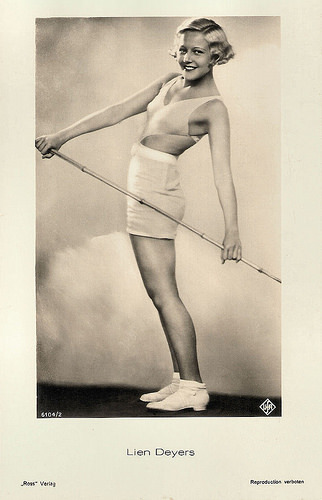
German postcard by Ross Verlag, no. 6104/2, 1931-1932. Photo: Ufa. Collection: Geoffrey Donaldson Institute.
Fritz Lang
Lien Deyers was born in Amsterdam as Nicolina Spanier. She was the daughter of Nathan Spanier, piano teacher, and Johanna Liefjes, seamstress. She had a half-brother, Andries Liefjes. After Spanier’s death mrs. Liefjes married the hotel-owner Egbert Dijjers and the family moved to The Hague. In 1931 Lien officially changed her name to Dijjers Spanier but would occasionally also use the name Dijjers Liefjes. At several times she stated her year of birth being 1910 or 1911, but some sources mention 1909 as the year of her birth.
She lived her childhood years in Amsterdam and later The Hague until her stepfather, owner of a big hotel in The Hague, married the Austrian actress Lotte Erol. Lien then traveled between The Hague, Vienna (where the family mostly lived) and Lausanne, where she went to a private school and became fluent in French. In August 1926 the Austrian weekly Mein Film staged a competition for new young screen talent and Lien submitted her photograph. Together with twenty other contestants she was chosen for a screen-test by director Hans Otto, which she won.
During an autograph session in the Mein Film offices in 1927, she was introduced to the Austrian director Fritz Lang. Reportedly, the Dutch teenager cheekily asked him: “Herr Lang, don’t you want to discover me?” The endeared director offered the self-assured little blonde girl a plum part in his next project, the thriller Spione/Spies (Fritz Lang, 1928) opposite Rudolf Klein-Rogge and Gerda Maurus . Lang had her travel to Berlin for a screentest and she was indeed given a secondary but racy role in Spione. She was billed as Lien Deyers because Dijjers was frequently misspelled or mispronounced in German speaking countries.
Lang had her sign a six-year contract and assigned her to the huge Ufa studios in Berlin. The contract soon turned out to be mere slavery, and Deyers sought a court decision to end it. In November 1928 the court ruled in her favour, a verdict welcomed by hundreds of Berlin-based actors with similar contracts. In turn Lang appealed and was granted a 10,000 Reichs-mark pay-off, to be fulfilled in monthly payments. Deyers and Lang had already grown to dislike each other during the shooting of Spione.
Her role as an alluring and seductive spy in Spione meant the start of a prolific film career in the German cinema for Lien. In the next two years she starred in films like Haus Nummer 17/Number 17 (Géza von Bolváry, 1928), Die Heilige und ihr Narr/The Saint and Her Fool (Wilhelm Dieterle, 1928) and the French adventure Le Capitaine Fracasse/Captain Fracasse (Alberto Cavalcanti, Henry Wulschleger, 1929) starring Pierre Blanchar.
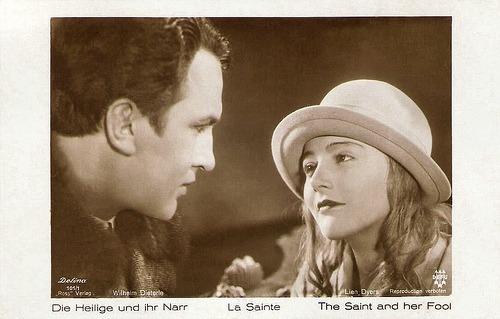
German postcard by Ross Verlag, no. 101/1, 1927-1928. Photo: Defina / DEFU. Publicity still for Die Heilige und ihr Narr/The Saint and her Fool (Wilhelm Dieterle, 1928) with Wilhelm Dieterle .
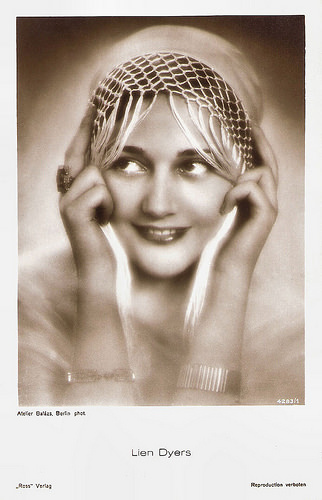
German postcard by Ross Verlag, no. 4283/1, 1929-1930. Photo: Atelier Balázs, Berlin. Collection: Geoffrey Donaldson Institute.
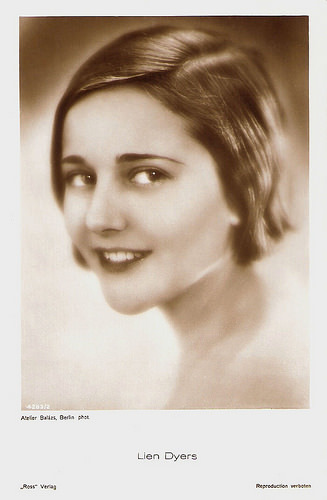
German postcard by Ross Verlag, no. 4283/2, 1929-1930. Photo: Atelier Balázs, Berlin.
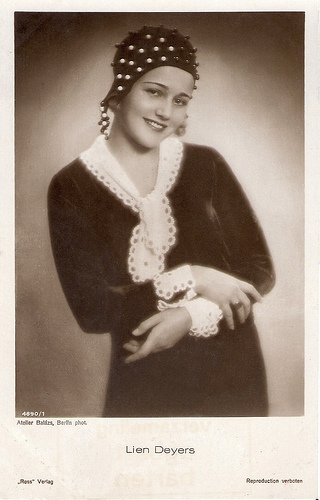
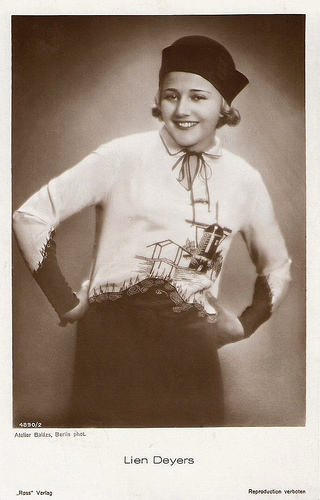
German postcards by Ross Verlag, no. 4890/1 and 4890/2, 1929-1930. Photo: Atelier Balázs, Berlin. Collection: Geoffrey Donaldson Institute.
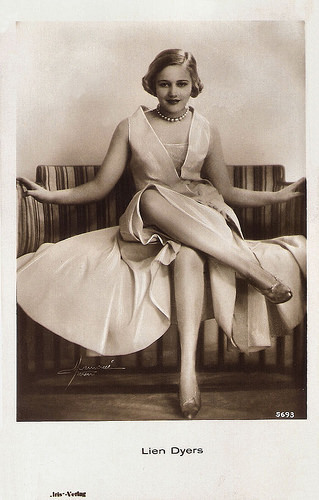
Austrian postcard by Iris Verlag, no. 5693. Photo: Manassé, Wien. Collection: Geoffrey Donaldson Institute.
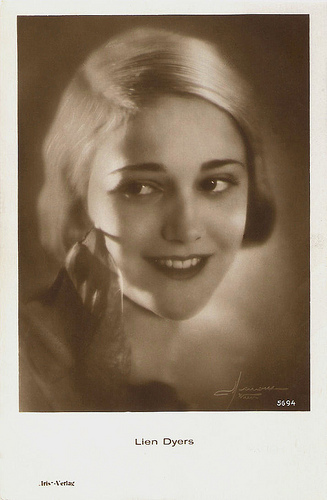
Austrian postcard by Iris-Verlag, no. 5694. Photo: Manassé.
Starring Parts
After eight silent films, Lien Deyers had also success with her early sound films. She enchanted the public with her appearances in films like Rosenmontag/Rose Monday (Hans Steinhoff, 1930), Die Männer um Lucie/The Men Around Lucie (Alexander Korda, 1931) starring Liane Haid , and the operetta Die Verliebte Firma/The Company's in Love (Max Ophüls, 1932) with Gustav Fröhlich .
She starred opposite Heinz Rühmann in the comedy hits Der Mann, der seinen Mörder sucht/Looking for His Murderer (Robert Siodmak, 1931) and Lachende Erben/Laughing Heirs (Max Ophüls, 1933).
Opposite the popular singer Richard Tauber , she appeared in Melodie der Liebe/Right to Happiness (Georg Jacoby, 1932), and opposite another singing star, Jan Kiepura in Ich liebe alle Frauen/I Love All Women (Carl Lamac, 1935).
In the interesting Sci-Fi film Gold (Karl Hartl, 1934) she played with Hans Albers and Brigitte Helm .
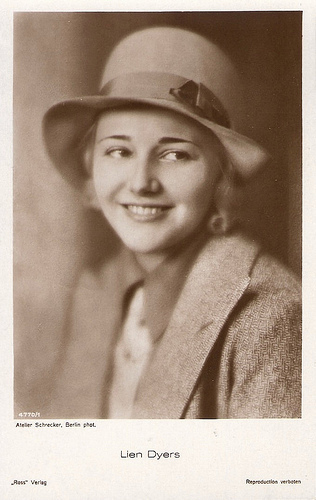
German postcard by Ross Verlag, no. 4770/1, 1929-1930. Photo: Atelier Schrecker, Berlin. Collection: Geoffrey Donaldson Institute.
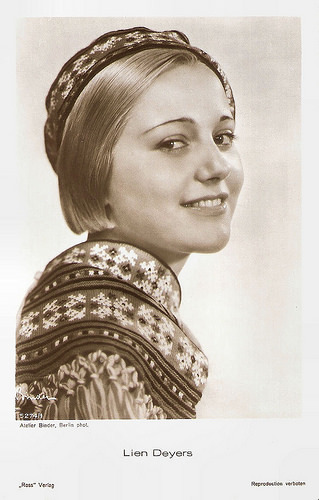
German postcard by Ross Verlag, no. 5274/1, 1930-1931. Photo: Atelier Binder. Collection: Geoffrey Donaldson Institute.

German postcard by Ross Verlag, no. 5274/2, 1930-1931. Photo: Atelier Binder, Berlin.
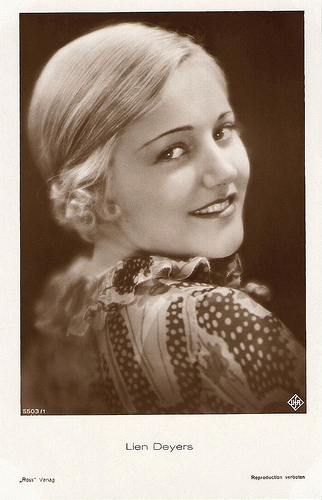
German postcard by Ross Verlag, no. 5503/1, 1930-1931. Photo: Ufa.
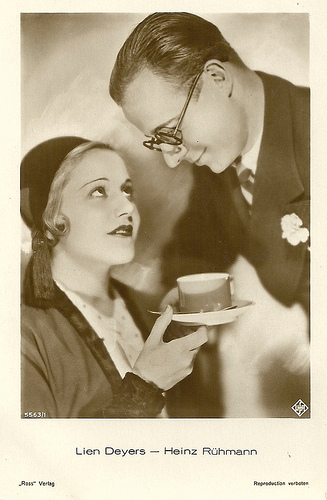
German postcard by Ross Verlag, no. 5563/1, 1930-1931. Photo: Ufa. Publicity still for Der Mann, der seinen Mörder sucht/Looking for His Murderer (Robert Siodmak, 1931) with Heinz Rühmann .
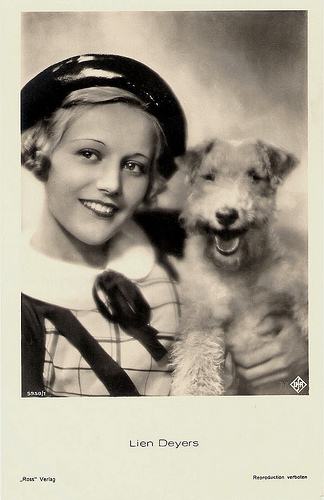
German postcard by Ross Verlag, no. 5950/1, 1930-1931. Photo: Ufa.
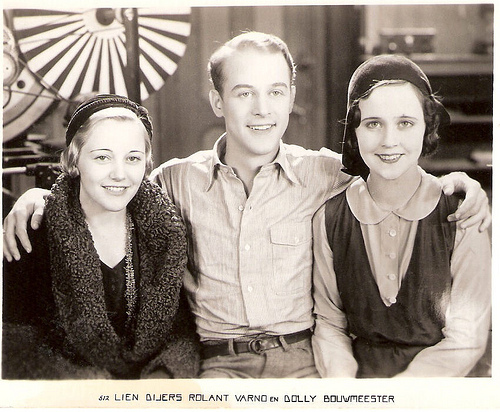
Dutch postcard for De sensatie der toekomst (Dimitri Buchowetzki, Jack Salvatori, 1931) with Roland Varno and Dolly Bouwmeester .
The Sensation of the Future
Lien Deyers' only part in a Dutch film was in De sensatie der toekomst/Television (Dimitri Buchowetzki, Jack Salvatori, 1931) starring Dolly Bouwmeester and Roland Varno .
This early and little known Dutch sound film was shot at the Paramount studio's in Joinville in France. The subject was the new phenomenon television, 'the sensation of the future.
De sensatie der toekomst/Television was the Dutch version of the French film Magie moderne/Modern Magic (Dimitri Buchowetzki, 1931). With different casts, there were also an Italian, a Czech, a Polish, a Romanian and a Swedish version produced in the same studio.
Deyers had given up her Dutch nationality when she married merican born German producer and director Alfred Zeisler. Zeisler had directed her in Sein Scheidungsgrund/His Grounds for Divorce (1931) and had produced Gold. Therefore Lien wasn't subject to the foreign-worker quota restrictions of the National Socialists.
Lien was terrified that her family tree would be investigated by the Nazis: her father, a hotel owner in the Hague, was half Jewish. Her husband was also Jewish. The couple decided to leave Germany.
Among Lien's last films were Ein ganzer Kerl/A Regular Fellow (Carl Boese, 1935) and Die Selige Exzellenz (Hans H. Zerlett, 1935). The pair left for England first.
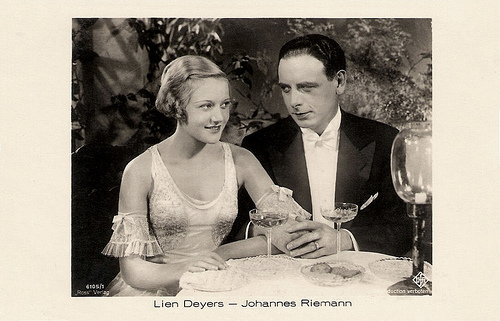
German postcard by Ross Verlag, no. 6105/1, 1931-1932. Photo: Ufa. Collection: Geoffrey Donaldson Institute. Publicity still for Sein Scheidungsgrund/His Grounds for Divorce (Alfred Zeisler, 1931) with Johannes Riemann .
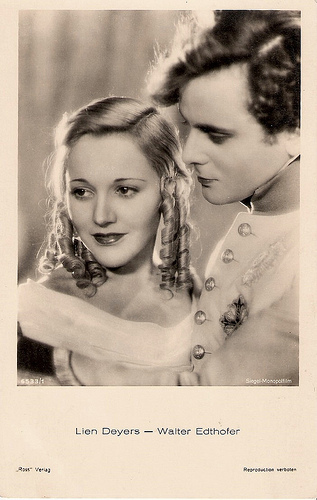
German postcard by Ross Verlag, no. 6533/1, 1931-1932. Photo: Siegel-Monopolfilm. Still from Der Herzog von Reichstadt/The Duke of Reichstadt (Victor Tourjansky, 1931) with Walter Edthofer. Collection: Geoffrey Donaldson Institute.
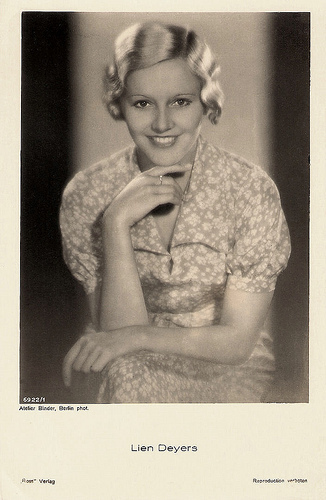
German postcard by Ross Verlag, no. 6922/1, 1931-1932. Photo: Atelier Binder, Berlin.
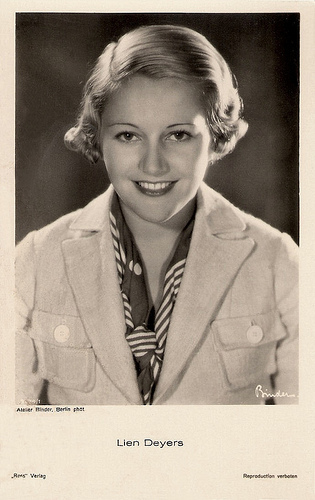
German postcard by Ross Verlag. Photo: Atelier Binder, Berlin.
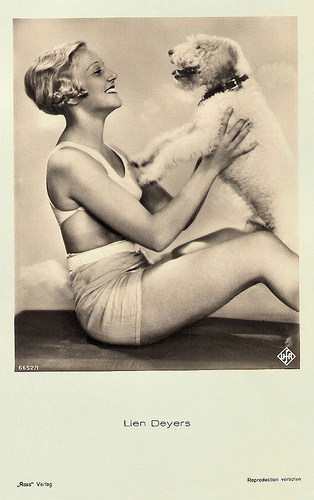
German postcard by Ross Verlag, no. 6552/1, 1931-1932. Photo: Ufa. Collection: Geoffrey Donaldson Institute.
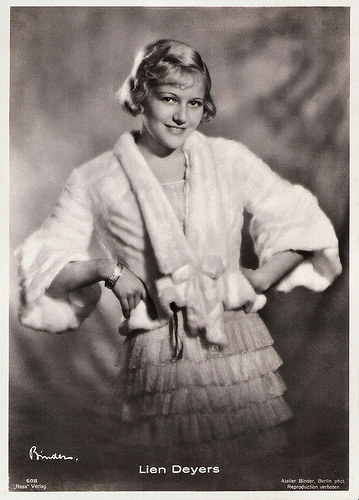
German postcard by Ross Verlag, no. 608 (Luxus series). Photo: Atelier Binder. Collection: Geoffrey Donaldson Institute.
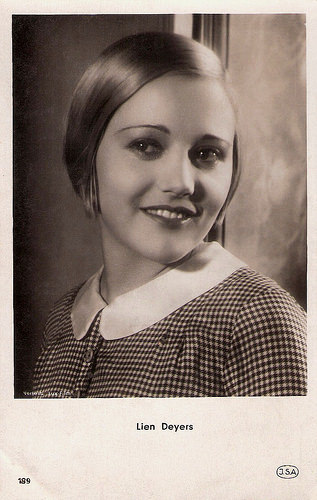
Dutch postcard by J.S.A., no. 189. Photo: Lux Film.
Setback
Lien Deyers traveled between London and The Hague while her man worked in England. In 1937 she signed for a major role in the Dutch-Italian film De Drie Wensen/I Tre Desideri/Three Wishes. For unknown reasons she did not play the part and finally joined her husband in London in 1938. There was no need for her acting skills there.
By that time her marriage with Alfred Zeissler was faltering and a divorce was inevitable. In 1939 the couple moved to California where they soon went their different ways. Lien Deyers couldn't find work in the film business in Hollywood, and conducted a business for novelties. According to Wikipedia she had a reputation now of being 'mentally extremely unstable'.
She developed an alcohol addiction and relied financially on old contacts like the German actor and director William Dieterle and in particular the Austrian-American film producer Paul Kohner and his European Film Fund that he had founded to aid down-on-their-luck German actors in exile.
Over a brief period of time she married three more times: with kingpin actors' agent Frank Orsatti, one of the Orsatti Brothers (who evidently couldn't get her involved in films either), from 1940 until 1942, with furrier Victor Rubin (from 1944 until 1948) and with Lawrence Adlon, grandson of the Berlin hotel-magnate, in January 1951.
In the following decades her private life was marked with some setbacks. Lien became an alcoholic. The Dutch actor/comedian Wim Sonneveld met with her in 1957 during the shooting of Silk Stockings with Fred Astaire and Cyd Charisse, in which he played a supporting role. He was reportedly shocked by her faded beauty.
Then, she completely vanished from the public view. The last time she was heard from, was in September 1964, when she was in the Clark County Jail in Las Vegas because of loitering and disorderly conduct.
Thomas Staedeli at Cyranos : "The time of her death is not ascertainable, (...) but it seems that she died in 1965". Wikipedia mentions a greeting card congratulating German actor and former co-star Heinz Rühmann on his eightieth birthday in 1982. The postcard was signed L. Dyers-Wallburg, suggesting she had gotten married for a fifth time. IMDb has 1982 as the year of her death.
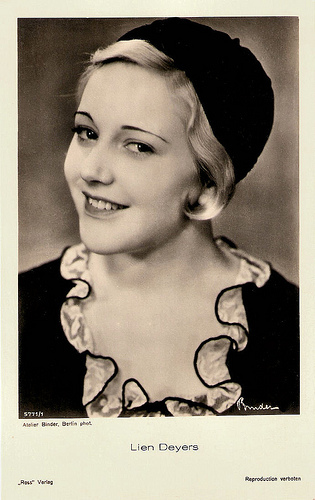
German postcard by Ross Verlag, no. 5771/1, 1930-1931. Photo: Alex Binder.
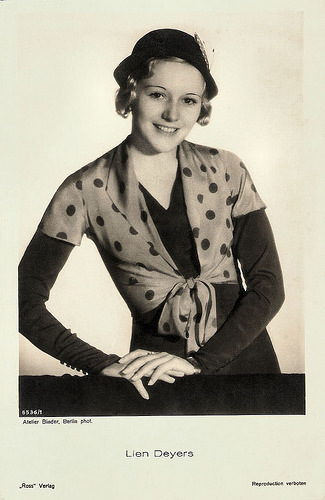
German postcard by Ross Verlag, no. 6536/1, 1931-1932. Photo: Atelier Binder. Collection: Geoffrey Donaldson Instituut.
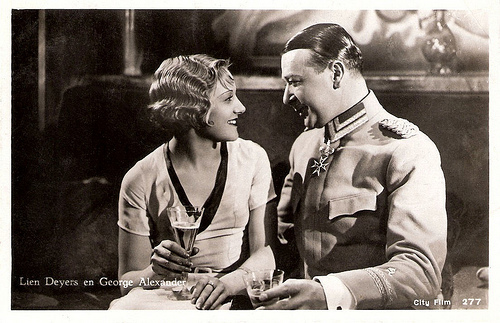
Dutch postcard by City Film, no. 277. Collection: Geoffrey Donaldson Institute. Publicity still for Ist mein Mann nicht fabelhaft?/Isn't My Husband Wonderful? (Georg Jacoby, 1933) with Georg Alexander .
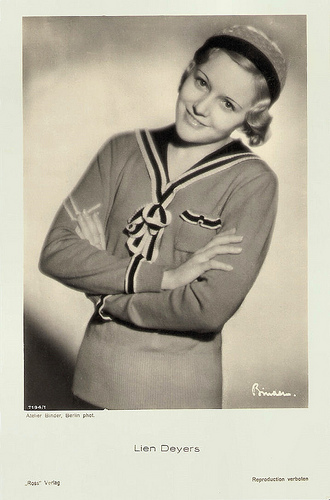
German postcard by Ross Verlag, no. 7194/1, 1932-1933. Photo: Atelier Binder, Berlin.
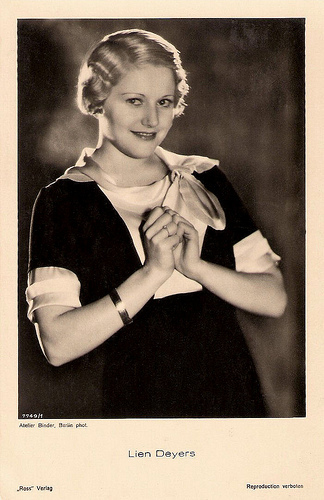
German postcard by Ross Verlag, no. 7749/1, 1932-1933. Photo: Atelier Binder, Berlin.
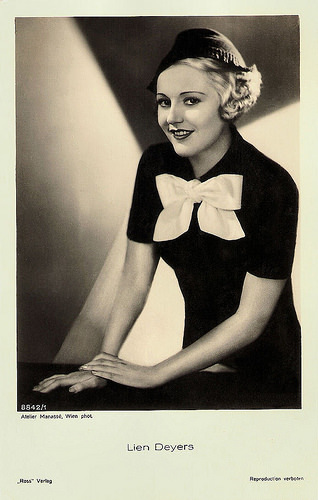
German postcard by Ross Verlag, no. 8842/1, 1933-1934. Photo: Atelier Manassé, Wien. Collection: Geoffrey Donaldson Institute.
Sources: Adrian Stahlecker (Nederlandse acteurs in de Weimarrepubliek en Nazi-Duitsland - Dutch), Thomas Staedeli (Cyranos), Filmportal.de, Wikipedia (English and Dutch) and .

German postcard by Ross Verlag, no. 5315/1, 1930-1931 Photo: Ufa. Collection: Geoffrey Donaldson Institute.

German postcard by Ross Verlag, no. 4714/1, 1929-1930. Photo: Universal.

German postcard by Ross Verlag, no. 5423/1, 1930-1931. Photo: Lola-Kreutzberg-Film.

German postcard by Ross Verlag, no. 5771/1, 1930-1931. Photo: Alex Binder.

German postcard by Ross-Verlag, no. 6922/2, 1931-1932. Photo: Atelier Binder. Collection: Geoffrey Donaldson Institute.

German postcard by Ross Verlag, no. 6104/2, 1931-1932. Photo: Ufa. Collection: Geoffrey Donaldson Institute.
Fritz Lang
Lien Deyers was born in Amsterdam as Nicolina Spanier. She was the daughter of Nathan Spanier, piano teacher, and Johanna Liefjes, seamstress. She had a half-brother, Andries Liefjes. After Spanier’s death mrs. Liefjes married the hotel-owner Egbert Dijjers and the family moved to The Hague. In 1931 Lien officially changed her name to Dijjers Spanier but would occasionally also use the name Dijjers Liefjes. At several times she stated her year of birth being 1910 or 1911, but some sources mention 1909 as the year of her birth.
She lived her childhood years in Amsterdam and later The Hague until her stepfather, owner of a big hotel in The Hague, married the Austrian actress Lotte Erol. Lien then traveled between The Hague, Vienna (where the family mostly lived) and Lausanne, where she went to a private school and became fluent in French. In August 1926 the Austrian weekly Mein Film staged a competition for new young screen talent and Lien submitted her photograph. Together with twenty other contestants she was chosen for a screen-test by director Hans Otto, which she won.
During an autograph session in the Mein Film offices in 1927, she was introduced to the Austrian director Fritz Lang. Reportedly, the Dutch teenager cheekily asked him: “Herr Lang, don’t you want to discover me?” The endeared director offered the self-assured little blonde girl a plum part in his next project, the thriller Spione/Spies (Fritz Lang, 1928) opposite Rudolf Klein-Rogge and Gerda Maurus . Lang had her travel to Berlin for a screentest and she was indeed given a secondary but racy role in Spione. She was billed as Lien Deyers because Dijjers was frequently misspelled or mispronounced in German speaking countries.
Lang had her sign a six-year contract and assigned her to the huge Ufa studios in Berlin. The contract soon turned out to be mere slavery, and Deyers sought a court decision to end it. In November 1928 the court ruled in her favour, a verdict welcomed by hundreds of Berlin-based actors with similar contracts. In turn Lang appealed and was granted a 10,000 Reichs-mark pay-off, to be fulfilled in monthly payments. Deyers and Lang had already grown to dislike each other during the shooting of Spione.
Her role as an alluring and seductive spy in Spione meant the start of a prolific film career in the German cinema for Lien. In the next two years she starred in films like Haus Nummer 17/Number 17 (Géza von Bolváry, 1928), Die Heilige und ihr Narr/The Saint and Her Fool (Wilhelm Dieterle, 1928) and the French adventure Le Capitaine Fracasse/Captain Fracasse (Alberto Cavalcanti, Henry Wulschleger, 1929) starring Pierre Blanchar.

German postcard by Ross Verlag, no. 101/1, 1927-1928. Photo: Defina / DEFU. Publicity still for Die Heilige und ihr Narr/The Saint and her Fool (Wilhelm Dieterle, 1928) with Wilhelm Dieterle .

German postcard by Ross Verlag, no. 4283/1, 1929-1930. Photo: Atelier Balázs, Berlin. Collection: Geoffrey Donaldson Institute.

German postcard by Ross Verlag, no. 4283/2, 1929-1930. Photo: Atelier Balázs, Berlin.


German postcards by Ross Verlag, no. 4890/1 and 4890/2, 1929-1930. Photo: Atelier Balázs, Berlin. Collection: Geoffrey Donaldson Institute.

Austrian postcard by Iris Verlag, no. 5693. Photo: Manassé, Wien. Collection: Geoffrey Donaldson Institute.

Austrian postcard by Iris-Verlag, no. 5694. Photo: Manassé.
Starring Parts
After eight silent films, Lien Deyers had also success with her early sound films. She enchanted the public with her appearances in films like Rosenmontag/Rose Monday (Hans Steinhoff, 1930), Die Männer um Lucie/The Men Around Lucie (Alexander Korda, 1931) starring Liane Haid , and the operetta Die Verliebte Firma/The Company's in Love (Max Ophüls, 1932) with Gustav Fröhlich .
She starred opposite Heinz Rühmann in the comedy hits Der Mann, der seinen Mörder sucht/Looking for His Murderer (Robert Siodmak, 1931) and Lachende Erben/Laughing Heirs (Max Ophüls, 1933).
Opposite the popular singer Richard Tauber , she appeared in Melodie der Liebe/Right to Happiness (Georg Jacoby, 1932), and opposite another singing star, Jan Kiepura in Ich liebe alle Frauen/I Love All Women (Carl Lamac, 1935).
In the interesting Sci-Fi film Gold (Karl Hartl, 1934) she played with Hans Albers and Brigitte Helm .

German postcard by Ross Verlag, no. 4770/1, 1929-1930. Photo: Atelier Schrecker, Berlin. Collection: Geoffrey Donaldson Institute.

German postcard by Ross Verlag, no. 5274/1, 1930-1931. Photo: Atelier Binder. Collection: Geoffrey Donaldson Institute.

German postcard by Ross Verlag, no. 5274/2, 1930-1931. Photo: Atelier Binder, Berlin.

German postcard by Ross Verlag, no. 5503/1, 1930-1931. Photo: Ufa.

German postcard by Ross Verlag, no. 5563/1, 1930-1931. Photo: Ufa. Publicity still for Der Mann, der seinen Mörder sucht/Looking for His Murderer (Robert Siodmak, 1931) with Heinz Rühmann .

German postcard by Ross Verlag, no. 5950/1, 1930-1931. Photo: Ufa.

Dutch postcard for De sensatie der toekomst (Dimitri Buchowetzki, Jack Salvatori, 1931) with Roland Varno and Dolly Bouwmeester .
The Sensation of the Future
Lien Deyers' only part in a Dutch film was in De sensatie der toekomst/Television (Dimitri Buchowetzki, Jack Salvatori, 1931) starring Dolly Bouwmeester and Roland Varno .
This early and little known Dutch sound film was shot at the Paramount studio's in Joinville in France. The subject was the new phenomenon television, 'the sensation of the future.
De sensatie der toekomst/Television was the Dutch version of the French film Magie moderne/Modern Magic (Dimitri Buchowetzki, 1931). With different casts, there were also an Italian, a Czech, a Polish, a Romanian and a Swedish version produced in the same studio.
Deyers had given up her Dutch nationality when she married merican born German producer and director Alfred Zeisler. Zeisler had directed her in Sein Scheidungsgrund/His Grounds for Divorce (1931) and had produced Gold. Therefore Lien wasn't subject to the foreign-worker quota restrictions of the National Socialists.
Lien was terrified that her family tree would be investigated by the Nazis: her father, a hotel owner in the Hague, was half Jewish. Her husband was also Jewish. The couple decided to leave Germany.
Among Lien's last films were Ein ganzer Kerl/A Regular Fellow (Carl Boese, 1935) and Die Selige Exzellenz (Hans H. Zerlett, 1935). The pair left for England first.

German postcard by Ross Verlag, no. 6105/1, 1931-1932. Photo: Ufa. Collection: Geoffrey Donaldson Institute. Publicity still for Sein Scheidungsgrund/His Grounds for Divorce (Alfred Zeisler, 1931) with Johannes Riemann .

German postcard by Ross Verlag, no. 6533/1, 1931-1932. Photo: Siegel-Monopolfilm. Still from Der Herzog von Reichstadt/The Duke of Reichstadt (Victor Tourjansky, 1931) with Walter Edthofer. Collection: Geoffrey Donaldson Institute.

German postcard by Ross Verlag, no. 6922/1, 1931-1932. Photo: Atelier Binder, Berlin.

German postcard by Ross Verlag. Photo: Atelier Binder, Berlin.

German postcard by Ross Verlag, no. 6552/1, 1931-1932. Photo: Ufa. Collection: Geoffrey Donaldson Institute.

German postcard by Ross Verlag, no. 608 (Luxus series). Photo: Atelier Binder. Collection: Geoffrey Donaldson Institute.

Dutch postcard by J.S.A., no. 189. Photo: Lux Film.
Setback
Lien Deyers traveled between London and The Hague while her man worked in England. In 1937 she signed for a major role in the Dutch-Italian film De Drie Wensen/I Tre Desideri/Three Wishes. For unknown reasons she did not play the part and finally joined her husband in London in 1938. There was no need for her acting skills there.
By that time her marriage with Alfred Zeissler was faltering and a divorce was inevitable. In 1939 the couple moved to California where they soon went their different ways. Lien Deyers couldn't find work in the film business in Hollywood, and conducted a business for novelties. According to Wikipedia she had a reputation now of being 'mentally extremely unstable'.
She developed an alcohol addiction and relied financially on old contacts like the German actor and director William Dieterle and in particular the Austrian-American film producer Paul Kohner and his European Film Fund that he had founded to aid down-on-their-luck German actors in exile.
Over a brief period of time she married three more times: with kingpin actors' agent Frank Orsatti, one of the Orsatti Brothers (who evidently couldn't get her involved in films either), from 1940 until 1942, with furrier Victor Rubin (from 1944 until 1948) and with Lawrence Adlon, grandson of the Berlin hotel-magnate, in January 1951.
In the following decades her private life was marked with some setbacks. Lien became an alcoholic. The Dutch actor/comedian Wim Sonneveld met with her in 1957 during the shooting of Silk Stockings with Fred Astaire and Cyd Charisse, in which he played a supporting role. He was reportedly shocked by her faded beauty.
Then, she completely vanished from the public view. The last time she was heard from, was in September 1964, when she was in the Clark County Jail in Las Vegas because of loitering and disorderly conduct.
Thomas Staedeli at Cyranos : "The time of her death is not ascertainable, (...) but it seems that she died in 1965". Wikipedia mentions a greeting card congratulating German actor and former co-star Heinz Rühmann on his eightieth birthday in 1982. The postcard was signed L. Dyers-Wallburg, suggesting she had gotten married for a fifth time. IMDb has 1982 as the year of her death.

German postcard by Ross Verlag, no. 5771/1, 1930-1931. Photo: Alex Binder.

German postcard by Ross Verlag, no. 6536/1, 1931-1932. Photo: Atelier Binder. Collection: Geoffrey Donaldson Instituut.

Dutch postcard by City Film, no. 277. Collection: Geoffrey Donaldson Institute. Publicity still for Ist mein Mann nicht fabelhaft?/Isn't My Husband Wonderful? (Georg Jacoby, 1933) with Georg Alexander .

German postcard by Ross Verlag, no. 7194/1, 1932-1933. Photo: Atelier Binder, Berlin.

German postcard by Ross Verlag, no. 7749/1, 1932-1933. Photo: Atelier Binder, Berlin.

German postcard by Ross Verlag, no. 8842/1, 1933-1934. Photo: Atelier Manassé, Wien. Collection: Geoffrey Donaldson Institute.
Sources: Adrian Stahlecker (Nederlandse acteurs in de Weimarrepubliek en Nazi-Duitsland - Dutch), Thomas Staedeli (Cyranos), Filmportal.de, Wikipedia (English and Dutch) and .
Published on September 28, 2016 22:00
September 27, 2016
De Big van het regiment (1935)
Every year in early autumn, the Netherlands Film Festival (NFF) takes place. For ten days, the city of Utrecht is the cinema capital of the Netherlands, and we join the fun with our own Unofficial Dutch Film Star Postcards Festival (UDFSPF). Today a film special about De Big van het regiment/The Darling of the Regiment (Max Nosseck, 1935), a First World War farce about the mobilisation of the Dutch Army.
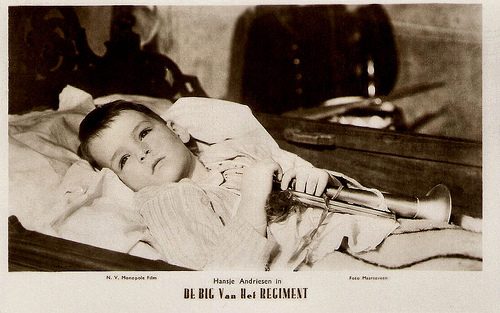
Dutch postcard by Monopole Film N.V. Photo: Dick van Maarseveen. Still for De Big van het Regiment/The Darling of the Regiment (Max Nosseck, 1935) with Hansje Andriesen. Collection: Geoffrey Donaldson Institute.
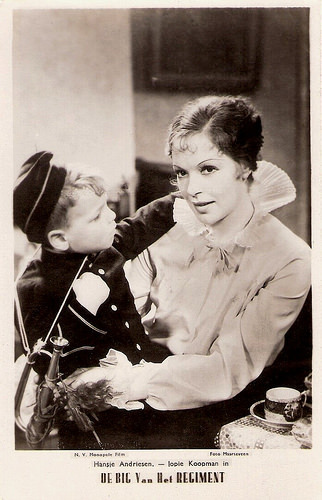
Dutch postcard by Monopole Film N.V., Rotterdam. Photo: Dick van Maarseveen. Publicity still for De Big van het regiment/The Darling of the Regiment (Max Nosseck, 1935) with Hansje Andriesen and Jopie Koopman .

Dutch postcard by Monopole Film N.V.. Photo: Dick van Maarseveen. Publicity still for De Big van het regiment/The Darling of the Regiment (Max Nosseck, 1935) with Matthieu van Eysden. Collection: Geoffrey Donaldson Institute.
The confidence of the critics was restored
De Big van het regiment (1935) is a Dutch film directed by German film director, actor and screenwriter Max Nosseck (1902-1972). Nosseck was born in Nakel - then in Prussia, but now in Poland. Nosseck established himself as a director in the German film industry of the 1920s. Due to his Jewish background he was forced to emigrate following the Nazi takeover in 1933. He directed films in Spain, the Netherlands and United States. After the Second World War, he returned to work in the German and Austrian film industries.
The scenario of De Big van het regiment was written by Herman Bouber, author of the box office hit De Jantjes/The Tars (Jaap Speyer, 1934), and German refugee writer Arnold Lipp. Their script was based on the novel Spionage in het veldleger (Espionage in the field army, 1933) by Mr. Anton Roothaert. In 1915 many Belgian citizens flee to the Netherlands because of the First World War. Reserve lieutenant Berkhage ( Frits van Dongen ) is sent to the Dutch-Belgian border to keep order in the flow of refugees. He then gets a refugee child (Hansje Andriesen) pushed into his arms. Named 'Big' by the company, he is soon the regimental darling.
Star of the film was the Dutch matinee idol Frits van Dongen (1901-1975). He was born Hein van der Niet and from 1940 on, he was billed in Hollywood as Philip Dorn . Van Dongen made his stage debut at age 14 and by the mid-1930s, he was a popular film actor in the Netherlands. From 1937 on, he worked in Germany with the likes of Veit Harlan. When World War II broke out, he moved to Hollywood and acted in several films, starting with Enemy Agent (Lew Landers, 1940). He was usually cast as Continental lovers, anti-Nazi Germans or refugees. In the 1950s, he returned to Europe and acted in a few German films and in a Dutch stage play.
The cast of De Big van het regiment is a 'who is who' of the Dutch cinema of the 1930s. The main female roles are played by film and cabaret diva Fien(tje) de la Mar and by another pretty film and cabaret artist, Jopie Koopman . The regiment includes such well known stage and film stars as Adolphe Engers , Matthieu van Eysden , Sylvain Poons and Johan Kaart.
For the search for the child who could play the title role, an advertisement was placed in a newspaper. Producer N.V. Monopole Film received a tsunami of letters. The four-year old Hansje And(e)riesen from Amsterdam was chosen. On the set, the little boy was assisted by his mother. He did not have to memorise the scenario, but just before the shooting, he was told what to do.
The premiere of De Big van het regiment took place in the Tuschinski Theater, the wonderful, still existing Art Deco cinema in Amsterdam. Several of the players were present. The critics were very positive. Various media wrote about how confidence in the Dutch film - especially after the disaster of De familie van mijn vrouw/The family of my wife (Jaap Speyer, 1935) - was restored!
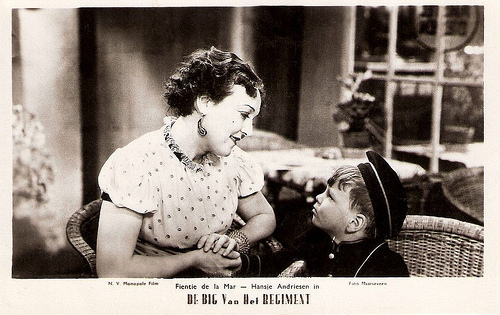
Dutch postcard by N.V. Monopole Film. Photo: Dick van Maarseveen. Fien(tje) de la Mar and Hansje Andriesen in De Big van het regiment/The Darling of the Regiment (Max Nosseck, 1935).
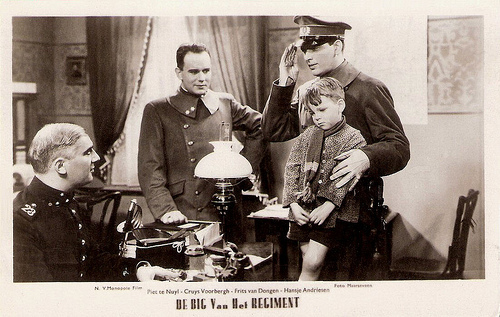
Dutch postcard by N.V. Monopole Film. Photo: Dick van Maarseveen. Still for De Big van het Regiment/The Darling of the Regiment (Max Nosseck, 1935) with Piet te Nuyl, Cruys Voorbergh, Frits van Dongen and Hansje Andriesen. Collection: Geoffrey Donaldson Institute.
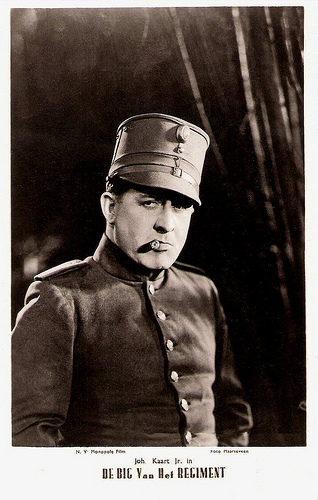
Dutch postcard by N.V. Monopole Film. Photo: Dick van Maarseveen. Publicity still for De Big van het regiment/The Darling of the Regiment (Max Nosseck, 1935) with Johan Kaart . Collection: Geoffrey Donaldson Institute.
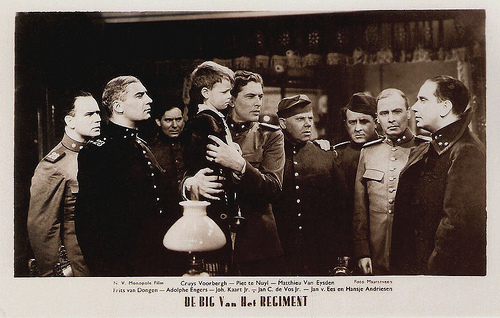
Dutch postcard by N.V. Monopole Film. Photo: Dick van Maarseveen. Still for De Big van het Regiment/The Darling of the Regiment (Max Nosseck, 1935) with Cruys Voorbergh, Piet te Nuyl, Matthieu van Eysden , Hansje Andriesen, Frits van Dongen , Adolphe Engers , Johan Kaart , Jan C. de Vos jr. and Jan van Ees. Collection: Geoffrey Donaldson Institute.
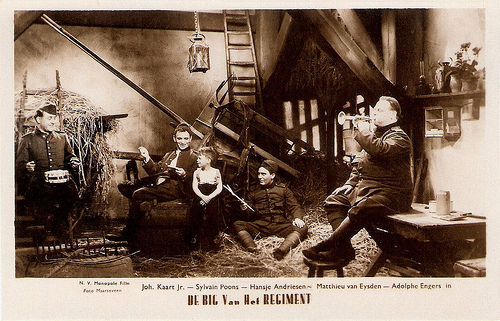
Dutch postcard by N.V. Monopole Film. Photo: Dick van Maarseveen. Still for De Big van het regiment/The Darling of the Regiment (Max Nosseck, 1935) with Johan Kaart , Sylvain Poons , Hansje Andriesen, Matthieu van Eysden , and Adolphe Engers . Collection: Geoffrey Donaldson Institute.
Sources: Wikipedia (Dutch and English) and IMDb.

Dutch postcard by Monopole Film N.V. Photo: Dick van Maarseveen. Still for De Big van het Regiment/The Darling of the Regiment (Max Nosseck, 1935) with Hansje Andriesen. Collection: Geoffrey Donaldson Institute.

Dutch postcard by Monopole Film N.V., Rotterdam. Photo: Dick van Maarseveen. Publicity still for De Big van het regiment/The Darling of the Regiment (Max Nosseck, 1935) with Hansje Andriesen and Jopie Koopman .

Dutch postcard by Monopole Film N.V.. Photo: Dick van Maarseveen. Publicity still for De Big van het regiment/The Darling of the Regiment (Max Nosseck, 1935) with Matthieu van Eysden. Collection: Geoffrey Donaldson Institute.
The confidence of the critics was restored
De Big van het regiment (1935) is a Dutch film directed by German film director, actor and screenwriter Max Nosseck (1902-1972). Nosseck was born in Nakel - then in Prussia, but now in Poland. Nosseck established himself as a director in the German film industry of the 1920s. Due to his Jewish background he was forced to emigrate following the Nazi takeover in 1933. He directed films in Spain, the Netherlands and United States. After the Second World War, he returned to work in the German and Austrian film industries.
The scenario of De Big van het regiment was written by Herman Bouber, author of the box office hit De Jantjes/The Tars (Jaap Speyer, 1934), and German refugee writer Arnold Lipp. Their script was based on the novel Spionage in het veldleger (Espionage in the field army, 1933) by Mr. Anton Roothaert. In 1915 many Belgian citizens flee to the Netherlands because of the First World War. Reserve lieutenant Berkhage ( Frits van Dongen ) is sent to the Dutch-Belgian border to keep order in the flow of refugees. He then gets a refugee child (Hansje Andriesen) pushed into his arms. Named 'Big' by the company, he is soon the regimental darling.
Star of the film was the Dutch matinee idol Frits van Dongen (1901-1975). He was born Hein van der Niet and from 1940 on, he was billed in Hollywood as Philip Dorn . Van Dongen made his stage debut at age 14 and by the mid-1930s, he was a popular film actor in the Netherlands. From 1937 on, he worked in Germany with the likes of Veit Harlan. When World War II broke out, he moved to Hollywood and acted in several films, starting with Enemy Agent (Lew Landers, 1940). He was usually cast as Continental lovers, anti-Nazi Germans or refugees. In the 1950s, he returned to Europe and acted in a few German films and in a Dutch stage play.
The cast of De Big van het regiment is a 'who is who' of the Dutch cinema of the 1930s. The main female roles are played by film and cabaret diva Fien(tje) de la Mar and by another pretty film and cabaret artist, Jopie Koopman . The regiment includes such well known stage and film stars as Adolphe Engers , Matthieu van Eysden , Sylvain Poons and Johan Kaart.
For the search for the child who could play the title role, an advertisement was placed in a newspaper. Producer N.V. Monopole Film received a tsunami of letters. The four-year old Hansje And(e)riesen from Amsterdam was chosen. On the set, the little boy was assisted by his mother. He did not have to memorise the scenario, but just before the shooting, he was told what to do.
The premiere of De Big van het regiment took place in the Tuschinski Theater, the wonderful, still existing Art Deco cinema in Amsterdam. Several of the players were present. The critics were very positive. Various media wrote about how confidence in the Dutch film - especially after the disaster of De familie van mijn vrouw/The family of my wife (Jaap Speyer, 1935) - was restored!

Dutch postcard by N.V. Monopole Film. Photo: Dick van Maarseveen. Fien(tje) de la Mar and Hansje Andriesen in De Big van het regiment/The Darling of the Regiment (Max Nosseck, 1935).

Dutch postcard by N.V. Monopole Film. Photo: Dick van Maarseveen. Still for De Big van het Regiment/The Darling of the Regiment (Max Nosseck, 1935) with Piet te Nuyl, Cruys Voorbergh, Frits van Dongen and Hansje Andriesen. Collection: Geoffrey Donaldson Institute.

Dutch postcard by N.V. Monopole Film. Photo: Dick van Maarseveen. Publicity still for De Big van het regiment/The Darling of the Regiment (Max Nosseck, 1935) with Johan Kaart . Collection: Geoffrey Donaldson Institute.

Dutch postcard by N.V. Monopole Film. Photo: Dick van Maarseveen. Still for De Big van het Regiment/The Darling of the Regiment (Max Nosseck, 1935) with Cruys Voorbergh, Piet te Nuyl, Matthieu van Eysden , Hansje Andriesen, Frits van Dongen , Adolphe Engers , Johan Kaart , Jan C. de Vos jr. and Jan van Ees. Collection: Geoffrey Donaldson Institute.

Dutch postcard by N.V. Monopole Film. Photo: Dick van Maarseveen. Still for De Big van het regiment/The Darling of the Regiment (Max Nosseck, 1935) with Johan Kaart , Sylvain Poons , Hansje Andriesen, Matthieu van Eysden , and Adolphe Engers . Collection: Geoffrey Donaldson Institute.
Sources: Wikipedia (Dutch and English) and IMDb.
Published on September 27, 2016 22:00
September 26, 2016
Dolly Mollinger
Every year in early autumn, the Netherlands Film Festival (NFF) takes place. For ten days, the city of Utrecht is the cinema capital of the Netherlands, and we join the fun with our own Unofficial Dutch Film Star Postcards Festival (UDFSPF). Today we feature beautiful Dolly Mollinger (1911-2004) who gained stardom in the 1930s. But whatever happened to the girl who was once called 'Netherlands’ most beloved secretary'?

French collectors card by Massilia.
A remarkable debut
Dolly Mollinger was born Margot Frédérique Amélie Eugénie Mollinger in Amsterdam, The Netherlands in 1911. She was the daughter of Theodore Godefroi Mollinger and Petronella Theodora Maters. Theodore Godefroi was a chemist and later deputy director of a dairy.
Dolly made her film debut opposite Cor Ruys and Frits van Dongen (a.k.a. Philip Dorn) in the comedy De Kribbebijter/The Cross-Patch (1935), which was directed by German director Hermann Kosterlitz and Ernst Winar .
It was remarkable that Mollinger got this leading role. She was working as a secretary at film distributor Universal at the time and did not have any experience as an actress. Director Hermann Kosterlitz preferred the beautiful secretary above Mary Dresselhuys and Lily Bouwmeester , two actresses who were well known.
Kosterlitz was probably right because the film was a success both among the critics and the public. A year later Kosterlitz moved to Hollywood, where he directed under the name Henry Koster many box office hits, starting with Deanna Durbin’s first film Three Smart Girls (1936).
After Dolly Mollinger’s success in De Kribbebijter followed supporting roles in the Dutch films Het leven is niet zo kwaad/Life is not so bad (Haro van Peski, 1935), starring Lou Bandy , and the tempestuous tropical romance Rubber (Johan de Meester, Gerard Rutten, 1936), filmed on Sumatra, now part of Indonesia.
Then, Mollinger played the female lead in the Dutch-French coproduction De man zonder hart/The Man without a heart (Léo Joannon, Louis de Bree, 1937), filmed in Paris.
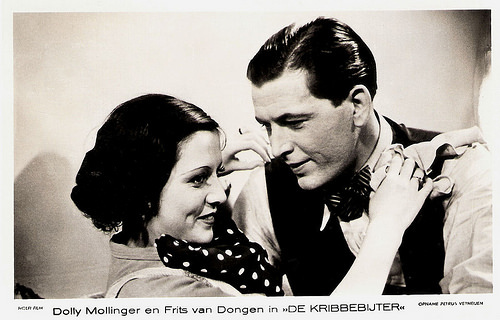
Dutch postcard by M. B . & Z. Photo: Holfi Film / Petrus Verheijen. Publicity still for De Kribbebijter/The Cross-Patch (Hermann Kosterlitz aka Henry Koster, 1935) with Frits van Dongen .
A beautiful narcissus
Dolly Mollinger continued her career abroad. In Great Britain, she appeared with Charles Laughton and Elsa Lanchester in Vessel of Wrath/The Beachcomber (Bartlett Cormack, Erich Pommer, 1938). Dutch newspapers reported that Mollinger was offered a Hollywood contract for five years by film producer and talent agent Myron Selznick.
However, in the following years, she starred in two French films, Altitude 3,200 (Jean Benoît-Lévy, Marie Epstein, 1938) with Jean-Louis Barrault , and her final film, Place de la Concorde (Carl Lamac, 1939) with Albert Préjean . Then the war broke off her film career.
Little is known about what happened with Dolly Mollinger during the war and later. Below, I made a compilation of the snippets of information I found in Dutch newspaper articles and other sources.
When the war started Dolly fled from Paris to Brittany.In 1939 she married German screenwriter Walter Schlee.In 1940 she was back in the Netherlands and announced she would appear in a Dutch variety show. If she really appeared on the Dutch stages is unclear.In 1943 the ANP correspondent in Berlin reported that after her work in France she had got a Ufa contract. However, there are no German films with her known.In 1943 she was writing a script, the ANP correspondent added. IMDb does indeed confirm that she wrote the scenario for the German film Komm zu mir zurück/Come back to me (Heinz Paul, 1944). This is her last film credit in the database.According to Wikipedia, Mollinger moved to the United States, but she had no luck in Hollywood. She worked in the U.S. as a school teacher.In 1952 Mollinger remarried with Gerhard Kimpel, an American citizen.
In the Netherlands, ‘Europe’s most beautiful secretary’ remained a sweet memory for some men. In 1958 J.W.A. Lefeber registrated a beautiful narcissus in white and yellow, named ‘Dolly Mollinger’. Nowadays, this narcissus is better known than the former actress.
The IMDb contains no information about her death. But according to Wikipedia, Dolly Mollinger died in Port Orchard, U.S.A., in 2004, a few months before her 93rd birthday.
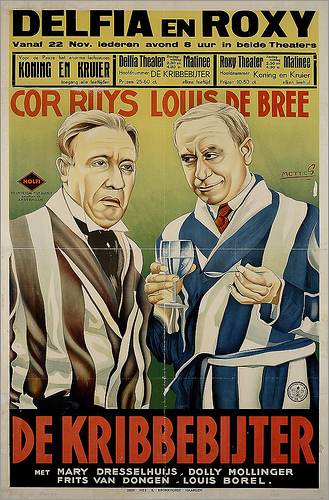
Dutch film poster for De kribbebijter (1935). Design: Frans Mettes.
Sources: Delpher (Dutch), AllMovie, Daffseek.org, Wikipedia (Dutch and French) and .

French collectors card by Massilia.
A remarkable debut
Dolly Mollinger was born Margot Frédérique Amélie Eugénie Mollinger in Amsterdam, The Netherlands in 1911. She was the daughter of Theodore Godefroi Mollinger and Petronella Theodora Maters. Theodore Godefroi was a chemist and later deputy director of a dairy.
Dolly made her film debut opposite Cor Ruys and Frits van Dongen (a.k.a. Philip Dorn) in the comedy De Kribbebijter/The Cross-Patch (1935), which was directed by German director Hermann Kosterlitz and Ernst Winar .
It was remarkable that Mollinger got this leading role. She was working as a secretary at film distributor Universal at the time and did not have any experience as an actress. Director Hermann Kosterlitz preferred the beautiful secretary above Mary Dresselhuys and Lily Bouwmeester , two actresses who were well known.
Kosterlitz was probably right because the film was a success both among the critics and the public. A year later Kosterlitz moved to Hollywood, where he directed under the name Henry Koster many box office hits, starting with Deanna Durbin’s first film Three Smart Girls (1936).
After Dolly Mollinger’s success in De Kribbebijter followed supporting roles in the Dutch films Het leven is niet zo kwaad/Life is not so bad (Haro van Peski, 1935), starring Lou Bandy , and the tempestuous tropical romance Rubber (Johan de Meester, Gerard Rutten, 1936), filmed on Sumatra, now part of Indonesia.
Then, Mollinger played the female lead in the Dutch-French coproduction De man zonder hart/The Man without a heart (Léo Joannon, Louis de Bree, 1937), filmed in Paris.

Dutch postcard by M. B . & Z. Photo: Holfi Film / Petrus Verheijen. Publicity still for De Kribbebijter/The Cross-Patch (Hermann Kosterlitz aka Henry Koster, 1935) with Frits van Dongen .
A beautiful narcissus
Dolly Mollinger continued her career abroad. In Great Britain, she appeared with Charles Laughton and Elsa Lanchester in Vessel of Wrath/The Beachcomber (Bartlett Cormack, Erich Pommer, 1938). Dutch newspapers reported that Mollinger was offered a Hollywood contract for five years by film producer and talent agent Myron Selznick.
However, in the following years, she starred in two French films, Altitude 3,200 (Jean Benoît-Lévy, Marie Epstein, 1938) with Jean-Louis Barrault , and her final film, Place de la Concorde (Carl Lamac, 1939) with Albert Préjean . Then the war broke off her film career.
Little is known about what happened with Dolly Mollinger during the war and later. Below, I made a compilation of the snippets of information I found in Dutch newspaper articles and other sources.
When the war started Dolly fled from Paris to Brittany.In 1939 she married German screenwriter Walter Schlee.In 1940 she was back in the Netherlands and announced she would appear in a Dutch variety show. If she really appeared on the Dutch stages is unclear.In 1943 the ANP correspondent in Berlin reported that after her work in France she had got a Ufa contract. However, there are no German films with her known.In 1943 she was writing a script, the ANP correspondent added. IMDb does indeed confirm that she wrote the scenario for the German film Komm zu mir zurück/Come back to me (Heinz Paul, 1944). This is her last film credit in the database.According to Wikipedia, Mollinger moved to the United States, but she had no luck in Hollywood. She worked in the U.S. as a school teacher.In 1952 Mollinger remarried with Gerhard Kimpel, an American citizen.
In the Netherlands, ‘Europe’s most beautiful secretary’ remained a sweet memory for some men. In 1958 J.W.A. Lefeber registrated a beautiful narcissus in white and yellow, named ‘Dolly Mollinger’. Nowadays, this narcissus is better known than the former actress.
The IMDb contains no information about her death. But according to Wikipedia, Dolly Mollinger died in Port Orchard, U.S.A., in 2004, a few months before her 93rd birthday.

Dutch film poster for De kribbebijter (1935). Design: Frans Mettes.
Sources: Delpher (Dutch), AllMovie, Daffseek.org, Wikipedia (Dutch and French) and .
Published on September 26, 2016 22:00
September 25, 2016
Louis Bouwmeester
Every year in early autumn, the Netherlands Film Festival (NFF) takes place. For ten days, the city of Utrecht is the cinema capital of the Netherlands, and we join the fun with our own Unofficial Dutch Film Star Postcards Festival (UDFSPF). Dutch stage and film actor Louis Bouwmeester (1842-1925) is often seen as ‘the greatest actor of the Netherlands’ ever. He was born in a dynasty of traveling actors and some of his 12 children would become well known actors too. His career span 65 years, and included several silent films.

Dutch postcard by N.J. Boon, Amsterdam. Photo: Louis Bouwmeester as Shylock in the play The Merchant of Venice by William Shakespeare.

Dutch postcard from 1910 showing Louis Bouwmeester as Shylock.
Passionate
Louis Frederik Johannes Bouwmeester was born in Middelharnis in 1842. His parents were the traveling actors Louis Rosenfeldt and Louisa Bouwmeester. He had three siblings and his youngest sister became the famous actress Theo Mann-Bouwmeester.
Louis started his stage career as a young boy and he would continue to play till he was 82. He made his start in popular melodramas, but in 1880 he was engaged by the prestigious theatre company Het Nederlandsch Tooneel (The Dutch Stage). There he became famous for his passionate and fiery roles in classic tragedies and comedies by William Shakespeare, Molière, Sophocles and Joost van den Vondel.
Bouwmeester caused a sensation in 1880 with his Shylock in Shakespeare's The Merchant of Venice. Recordedly, his Shylock was a rendering of remarkable originality and great tragic force. In the following forty years he would play this part over two thousand times.
The role established his fame throughout Europe. He played Shylock at the Comédie Francaise in Paris, in the Royal Theatre Berlin (1911), the Burgtheater in Vienna (1921) and in the Duke of York’s Theatre in London (1920).
The Times wrote in 1920 that Bouwmeester “speaking his native language, roused his English auditors to the highest pitch of excitement and enthusiasm.”

Dutch postcard by Uitg. N.J. Boon, Amsterdam. Sent by mail in 1901. Photo: publicity still for the stage play Gier-Wally (Die Geier-Wally/The Vulture Maiden, 1885) by Wilhelmina von Hillern.

Dutch postcard by Ed. N.J. Boon, Amsterdam. The card seems dated as 14 December 1901. Louis Bouwmeester as Herod. It was on 19 December 1901 that Bouwmeester first performed Herod, a part created in 1900 by Herbert Beerbohm Tree on basis of a text by Stephan Phillips. Bouwmeester did so at his regular stage company Nederlandsch Tooneel, during a special night to remember the 40 years of his stage career.
Car Accident
Strikingly Louis Bouwmeester was the first major Dutch actor who worked for the cinema. In 1909 he made his film debut in De Greep/The Grip (Leon Boedels, 1909) based on La griffe by Jean Sartène, produced by Filmfabriek F.A. Nöggerath.
Between 1909 and 1924 he acted in several more silent films, including the Dutch-French coproduction Het vervloekte Geld/L'or qui brule/Arson at Sea (Alfred Machin, 1911-1912), Koning Oedipus/Oedipus (Leon Boedels, 1912), Fatum (Theo Frenkel, 1915) with Henriëtte Davids , De duivel in Amsterdam/The Devil in Amsterdam (Theo Frenkel, 1918) with Eduard Verkade , and Pro Domo (Theo Frenkel, 1918).
In Pro Domo, his sister Theo Mann-Bouwmeester appeared as his wife and their grand-niece Lily Bouwmeester played their daughter.
His last film part was as a circus director in Cirque Hollandais/Circus Hollandais (Theo Frenkel, 1924) with a young Johan Heesters in a supporting part. Bouwmeester was already more than 80 years old, when he played this role.
Sadly only fragments of his feature films have survived. He often performed live in cinemas before the screenings.
Bouwmeester died in Amsterdam in 1925 after a car accident. In 1955 the Louis d’Or, the award for the best male stage performance in The Netherlands was named after him. Among his many children of his six marriages and several extra-marital relationships are the actresses Tilly Perin-Bouwmeester and Wiesje Bouwmeester. Actor Henri de Vries was his nephew and the film actresses Dolly Bouwmeester and Lily Bouwmeester were grand-nieces.

Modern Dutch postcard. Louis Bouwmeester as Jacques Frochard in the stage play De Twee Weezen (Les Deux Orphelines/The Two Orphans) by Adolph D'Ennery and Eugene Cormon, 1875. Photo: Albert Greiner.

Modern Dutch postcard by Witcard, Amsterdam. Photo: collection Nederlands Theater Instituut, Amsterdam. Publicity still for the stage tragedy Narciss (Narziss/Narcisse, 1875) by Albert Emil Brachvogel.

Dutch postcard in the series Hollandsche Kunstenaars (Dutch Artists) by Nederlandsche Uitgevers-Mij, Den Haag, 1920, Series I. Photo: Frits Geveke.
Sources: Simon Koster (De Bouwmeesters - Dutch), H.H.J. de Leeuwe (Historici.nl - Dutch), Film in NL (Eye - Dutch), Een leven lang theater (Dutch), Wikipedia (Dutch) and .

Dutch postcard by N.J. Boon, Amsterdam. Photo: Louis Bouwmeester as Shylock in the play The Merchant of Venice by William Shakespeare.

Dutch postcard from 1910 showing Louis Bouwmeester as Shylock.
Passionate
Louis Frederik Johannes Bouwmeester was born in Middelharnis in 1842. His parents were the traveling actors Louis Rosenfeldt and Louisa Bouwmeester. He had three siblings and his youngest sister became the famous actress Theo Mann-Bouwmeester.
Louis started his stage career as a young boy and he would continue to play till he was 82. He made his start in popular melodramas, but in 1880 he was engaged by the prestigious theatre company Het Nederlandsch Tooneel (The Dutch Stage). There he became famous for his passionate and fiery roles in classic tragedies and comedies by William Shakespeare, Molière, Sophocles and Joost van den Vondel.
Bouwmeester caused a sensation in 1880 with his Shylock in Shakespeare's The Merchant of Venice. Recordedly, his Shylock was a rendering of remarkable originality and great tragic force. In the following forty years he would play this part over two thousand times.
The role established his fame throughout Europe. He played Shylock at the Comédie Francaise in Paris, in the Royal Theatre Berlin (1911), the Burgtheater in Vienna (1921) and in the Duke of York’s Theatre in London (1920).
The Times wrote in 1920 that Bouwmeester “speaking his native language, roused his English auditors to the highest pitch of excitement and enthusiasm.”

Dutch postcard by Uitg. N.J. Boon, Amsterdam. Sent by mail in 1901. Photo: publicity still for the stage play Gier-Wally (Die Geier-Wally/The Vulture Maiden, 1885) by Wilhelmina von Hillern.

Dutch postcard by Ed. N.J. Boon, Amsterdam. The card seems dated as 14 December 1901. Louis Bouwmeester as Herod. It was on 19 December 1901 that Bouwmeester first performed Herod, a part created in 1900 by Herbert Beerbohm Tree on basis of a text by Stephan Phillips. Bouwmeester did so at his regular stage company Nederlandsch Tooneel, during a special night to remember the 40 years of his stage career.
Car Accident
Strikingly Louis Bouwmeester was the first major Dutch actor who worked for the cinema. In 1909 he made his film debut in De Greep/The Grip (Leon Boedels, 1909) based on La griffe by Jean Sartène, produced by Filmfabriek F.A. Nöggerath.
Between 1909 and 1924 he acted in several more silent films, including the Dutch-French coproduction Het vervloekte Geld/L'or qui brule/Arson at Sea (Alfred Machin, 1911-1912), Koning Oedipus/Oedipus (Leon Boedels, 1912), Fatum (Theo Frenkel, 1915) with Henriëtte Davids , De duivel in Amsterdam/The Devil in Amsterdam (Theo Frenkel, 1918) with Eduard Verkade , and Pro Domo (Theo Frenkel, 1918).
In Pro Domo, his sister Theo Mann-Bouwmeester appeared as his wife and their grand-niece Lily Bouwmeester played their daughter.
His last film part was as a circus director in Cirque Hollandais/Circus Hollandais (Theo Frenkel, 1924) with a young Johan Heesters in a supporting part. Bouwmeester was already more than 80 years old, when he played this role.
Sadly only fragments of his feature films have survived. He often performed live in cinemas before the screenings.
Bouwmeester died in Amsterdam in 1925 after a car accident. In 1955 the Louis d’Or, the award for the best male stage performance in The Netherlands was named after him. Among his many children of his six marriages and several extra-marital relationships are the actresses Tilly Perin-Bouwmeester and Wiesje Bouwmeester. Actor Henri de Vries was his nephew and the film actresses Dolly Bouwmeester and Lily Bouwmeester were grand-nieces.

Modern Dutch postcard. Louis Bouwmeester as Jacques Frochard in the stage play De Twee Weezen (Les Deux Orphelines/The Two Orphans) by Adolph D'Ennery and Eugene Cormon, 1875. Photo: Albert Greiner.

Modern Dutch postcard by Witcard, Amsterdam. Photo: collection Nederlands Theater Instituut, Amsterdam. Publicity still for the stage tragedy Narciss (Narziss/Narcisse, 1875) by Albert Emil Brachvogel.

Dutch postcard in the series Hollandsche Kunstenaars (Dutch Artists) by Nederlandsche Uitgevers-Mij, Den Haag, 1920, Series I. Photo: Frits Geveke.
Sources: Simon Koster (De Bouwmeesters - Dutch), H.H.J. de Leeuwe (Historici.nl - Dutch), Film in NL (Eye - Dutch), Een leven lang theater (Dutch), Wikipedia (Dutch) and .
Published on September 25, 2016 22:00
September 24, 2016
Johannes Heesters
Every year in early autumn, the Netherlands Film Festival (NFF) takes place. For ten days, the city of Utrecht is the cinema capital of the Netherlands, and we join the fun with our own Unofficial Dutch Film Star Postcards Festival (UDFSPF). Dutch born actor, singer, and entertainer Johannes Heesters (1903-2011) was active both on stage, television and in film. The Dutch tenor was specialized in the Viennese operetta. His 91-year career began in Amsterdam in 1920 and in 1935 Heesters moved to Germany. There he enjoyed many successes and reportedly became 'Adolf Hitler’s favourite actor', which would colour his further career.
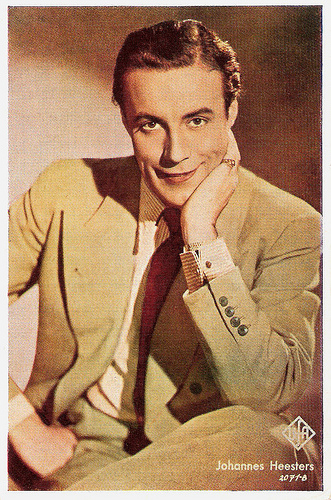
Czech postcard, no. 2071-B. Photo: UFA.
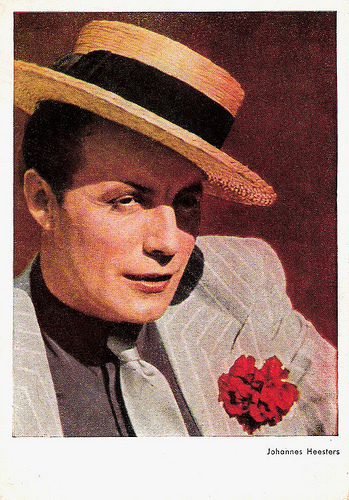
German postcard by Verlag und Druckerei Erwin Preuss, Dresden-Freital. Photo: Charlott Serda.
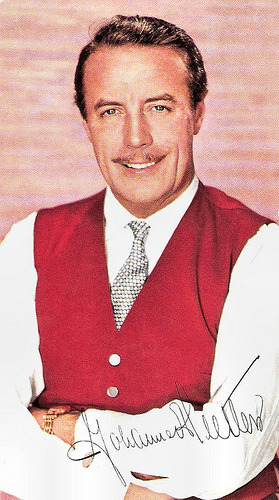
German collectors card by Lux.
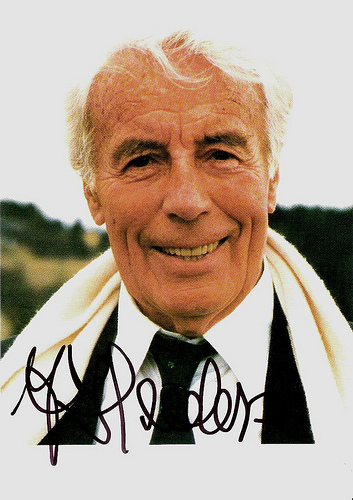
Vintage promotion card.
From Amsterdam to Vienna
Johan Marius Nicolaas Heesters was born in 1903 in Amersfoort, Netherlands. 'Jopie' made his stage debut in 1921 as a 17-year-old.
In 1923 he had his first singing role in a Dutch stage production of August Strindbergs Ett Drőmspel (A Dream Play). Many roles in operettas like Walzertraum, Dreimäderlhaus and König der Vagabunden followed.
A year later he made his film debut in the Dutch silent film Cirque hollandais/Dutch Circus (Theo Frenkel, 1924) starring the legendary stage actor Louis Bouwmeester .
When sound film was introduced, Johan Heesters played and sang in the Dutch film comedies Bleeke Bet (Alex Benno, Richard Oswald, 1934) and De vier Mullers/The Four Mullers (Rudolf Meinert, 1935). The latter was filmed in Vienna and was also shot there in a German spoken version as Alles für die Firma/Everything for the Firm (Rudolf Meinert, 1935).
In 1934 Heesters had made his Viennese stage debut at the Volksoper in Karl Millöcker's Der Bettelstudent/The Beggar Student. It was a huge success and many more operettas followed. Over the decades, Da geh' ich ins Maxim, Count Danilo Danilovitch's entrance song from Franz Lehár's Die Lustige Witwe/The Merry Widow would become Heesters's signature tune. He played Danilo with white silk scarf and top hat for 32 years 1600 times on stage, from 1938 to 1970.
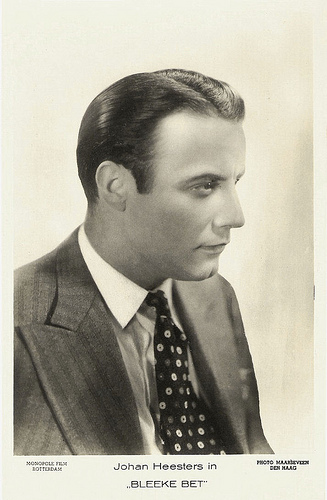
Dutch postcard by M. B. & Z. (M. Bonnist & Zonen, Amsterdam). Photo: Monopole Film, Rotterdam / Maarseveen, Den Haag. Publicity still for Bleeke Bet (1934).
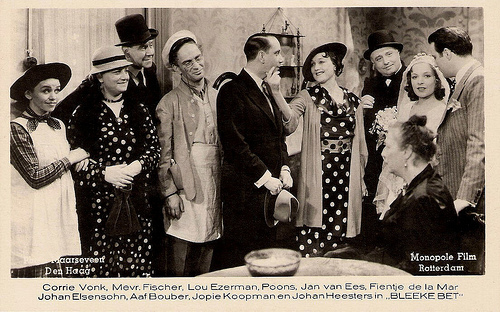
Photo: Monopole Film, Rotterdam / Maarseveen, Den Haag. Publicity still for Bleeke Bet (1934). Johan Heesters as the bridegroom at the far right.
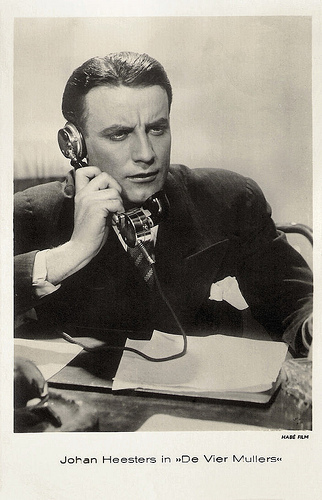
Dutch postcard by Habé Film. Sent by mail in 1935. Photo: publicity still for De Vier Mullers/The Four Mullers (Rudolf Meinert, 1935).
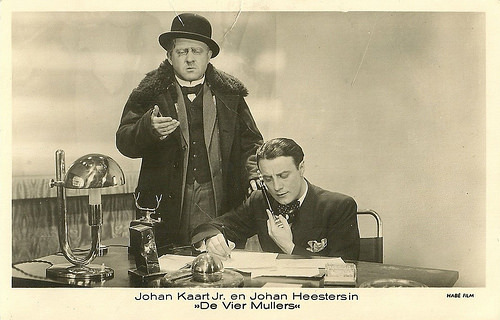
Dutch postcard by Habé Film. Photo: publicity still for De Vier Mullers/The Four Mullers (Rudolf Meinert, 1935) with Johan Kaart.
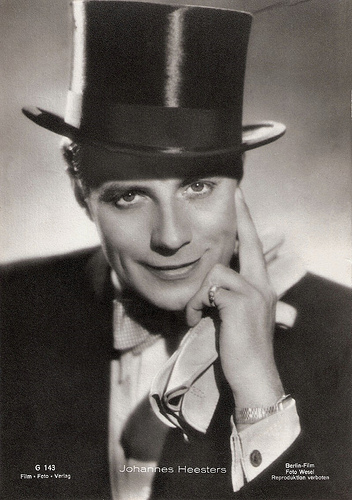
German postcard by Film-Foto-Verlag, no. G 143, 1941-1944. Photo: Berlin-Film / Wesel.
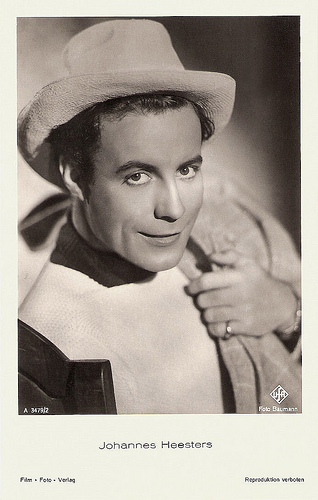
German postcard by Film-Foto-Verlag, no. A 3479/2, 1941-1944. Photo: Baumann / UFA.
Dream Couple
From 1936 on, Johannes Heesters played in various Ufa films. Many of his stage successes were also made into musical films, such as the Der Bettelstudent/The Beggar Student (Georg Jacoby, 1936) with Carola Höhn .
In Gasparone (1937, Georg Jacoby) and the musical Hallo Janine!/Hello, Janine! (1939, Carl Boese), he starred with Marika Rökk . They were called the Dream Couple of the German Musical film.
Other popular films with Heesters were Das Hofkonzert/The Court Concert (Detlev Sierck aka Douglas Sirk, 1936) with Márta Eggerth ; and Illusion (Viktor Tourjansky, 1941) with Brigitte Horney .
In the spring of 1939 he performed in the operetta Gräfin Mariza/Countess Maritza in Amsterdam and The Hague with an ensemble of emigrated Jewish performers. The Nazis later criticized him for this cooperation, but till almost the end of WW II Heesters worked extensively for the Nazi-controlled UFA.
His last wartime film was Die Fledermaus/The Bat (Géza von Bolváry, 1946, produced in 1945) with Marte Harell . After the war he was never accused of being a Nazi propagandist, and the Allies allowed him to continue performing in post-war Germany and Austria.
He played both on the stage and in films. Die Czardasfürstin/The Csardas Princess (Georg Jacoby, 1951) reunited him with Marika Rökk . Memorable was his lead in the film Bel Ami (Louis Daquin, 1955). Little known is his part in the German version of Otto Preminger's The Moon is Blue, entitled Die Jungfrau auf dem Dach/The Girl on the Roof (Otto Preminger, 1953).
After the Schlagerfilm Junge Leute brauchen Liebe/Young People Need Love (Géza von Cziffra, 1961) with Conny Froboess and Peter Weck , he stopped making films and concentrated on stage and television appearances and on producing records.
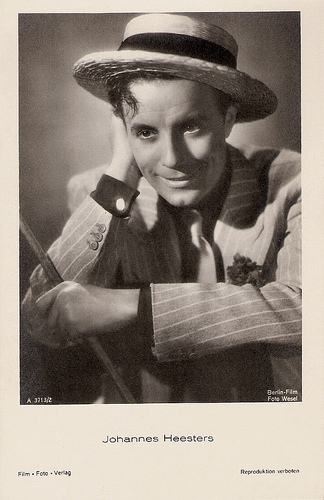
German postcard by Film-Foto-Verlag, no. A 3713/2, 1941-1944. Photo: Berlin-Film / Wesel.

German postcard by Film-Foto-Verlag, no. A 3713/1, 1941-1944. Photo: Manninger / Berlin-Film.

German postcard by Film-Foto-Verlag, no. A 3713/3, 1941-1944. Photo: Binz / UFA.
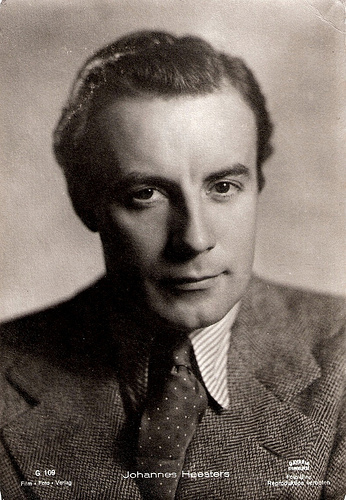
German postcard by Film-Foto-Verlag, no. G 109, ca. 1941-1944. Photo: Binz / Bavaria Filmkunst.

German postcard by Film-Foto-Verlag, no. A 3570/1, 1941-1944. Photo: Binz / Bavaria Filmkunst.
Booed Off the Stage
Johannes Heesters had moved to Germany in 1935. There he performed for Adolf Hitler (according to IMDb he was the Führer’s favourite actor) and he visited the Dachau concentration camp. After the war, many Dutch people could not forgive him this visit. In the early 1960s he was booed off the stage in Amsterdam when he tried to make a comeback in the Netherlands with The Sound of Music.
Since then he performed notably in Germany and Austria. Heesters has two daughters by his first wife, the Belgian actress Louise ‘Wiesje’ Ghijs, whom he married in 1930 and who was his co-star in De vier Mullers (Rudolf Meinert, 1935).
After her death in 1985, Heesters remarried in 1991 with German actress Simone Rethel. His younger daughter Nicole Heesters and his granddaughter Saskia Fischer are well-known actresses in the German-speaking countries.
In 2008 he apologised for his cooperation with the Nazi regime. In February of that year Johannes Heesters performed in his birthplace Amersfoort. This was the first stage appearance in four decades in his home country. Despite protests against his Nazi associations the performance became a triumph for the old star.
In 2008 he also played a scene in another film, 1 1/2 Ritter - Auf der Suche nach der hinreißenden Herzelinde/1½ Knights - In Search of the Ravishing Princess Herzelinde (Til Schweiger, 2008). His final film was the short Ten (Stefan Hering, 2011) in which he played St. Peter. At the gates of heaven, a man (Christof Arnold) has only one chance to come back to his little ill daughter: to win a bet against St. Peter. He has to break all ten commandments within 30 minutes in Munich's most notorious bar!
Heesters could not attend the premiere, while at 29 November 2011 he was admitted to a hospital because of a fever. He thus also missed the Bambi award show, where he was offered his 10th Bambi statue. And o 25 Decembern 2011, the 108 year old 'Jopie' passed away for good in a hospital in Starnberg.
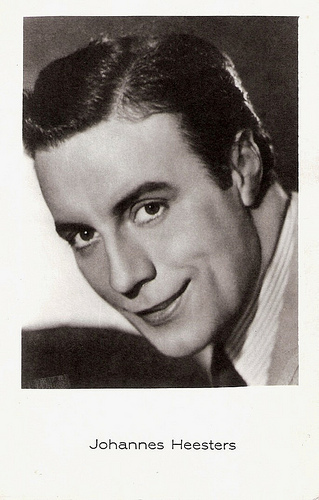
Vintage postcard.
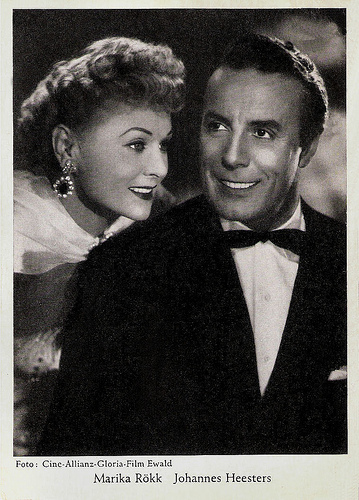
German collectors card. Photo: Cine-Allianz / Gloria / Film Ewald. Publicity still for Die geschiedene Frau/The Divorcée (George Jacoby, 1953) with Marika Rökk .
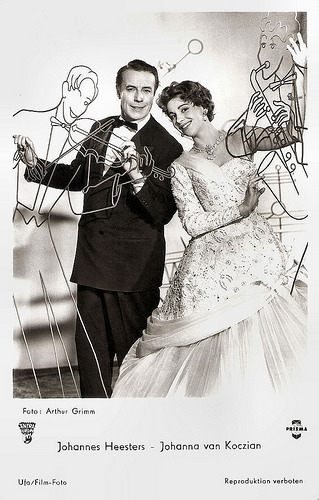
German postcard by Ufa, Berlin-Tempelhof, no. CK-60. Photo: Arthur Grimm / Central Europa Film / Prisma. Publicity still for Viktor und Viktoria/Viktor and Viktoria (Karl Anton, 1957) with Johanna von Koczian .

German postacrd by Rüdel-Verlag, Hamburg-Bergedorf, no. 125. Photo: Junge Film Union / Foto Wesel.
Johan (Johannes) Heesters sings De ode aan de Westertoren in Bleeke Bet (1934). The tower (the Westertoren in Amsterdam) is the same one as Anne Frank describes in her diary. The lovely girl in the clip is Bleeke Bet herself, played by Jopie Koopman . Source: brassens66 (YouTube).
Johannes Heesters and Edith Schollwer sing Ich werde jede nacht von Ihnen traumen in a clip from Gasparone (1937). Source: Ein Lied Geht Um Die Welt (YouTube).
Johannes Heesters in Amersfoort in 2008. He sings Nou tabé dan. Source: Mokum tv (YouTube)
Sources: Wikipedia, Eric Kelsey (Reuters), johannes-heesters.de (German), Filmportal.de and .

Czech postcard, no. 2071-B. Photo: UFA.

German postcard by Verlag und Druckerei Erwin Preuss, Dresden-Freital. Photo: Charlott Serda.

German collectors card by Lux.

Vintage promotion card.
From Amsterdam to Vienna
Johan Marius Nicolaas Heesters was born in 1903 in Amersfoort, Netherlands. 'Jopie' made his stage debut in 1921 as a 17-year-old.
In 1923 he had his first singing role in a Dutch stage production of August Strindbergs Ett Drőmspel (A Dream Play). Many roles in operettas like Walzertraum, Dreimäderlhaus and König der Vagabunden followed.
A year later he made his film debut in the Dutch silent film Cirque hollandais/Dutch Circus (Theo Frenkel, 1924) starring the legendary stage actor Louis Bouwmeester .
When sound film was introduced, Johan Heesters played and sang in the Dutch film comedies Bleeke Bet (Alex Benno, Richard Oswald, 1934) and De vier Mullers/The Four Mullers (Rudolf Meinert, 1935). The latter was filmed in Vienna and was also shot there in a German spoken version as Alles für die Firma/Everything for the Firm (Rudolf Meinert, 1935).
In 1934 Heesters had made his Viennese stage debut at the Volksoper in Karl Millöcker's Der Bettelstudent/The Beggar Student. It was a huge success and many more operettas followed. Over the decades, Da geh' ich ins Maxim, Count Danilo Danilovitch's entrance song from Franz Lehár's Die Lustige Witwe/The Merry Widow would become Heesters's signature tune. He played Danilo with white silk scarf and top hat for 32 years 1600 times on stage, from 1938 to 1970.

Dutch postcard by M. B. & Z. (M. Bonnist & Zonen, Amsterdam). Photo: Monopole Film, Rotterdam / Maarseveen, Den Haag. Publicity still for Bleeke Bet (1934).

Photo: Monopole Film, Rotterdam / Maarseveen, Den Haag. Publicity still for Bleeke Bet (1934). Johan Heesters as the bridegroom at the far right.

Dutch postcard by Habé Film. Sent by mail in 1935. Photo: publicity still for De Vier Mullers/The Four Mullers (Rudolf Meinert, 1935).

Dutch postcard by Habé Film. Photo: publicity still for De Vier Mullers/The Four Mullers (Rudolf Meinert, 1935) with Johan Kaart.

German postcard by Film-Foto-Verlag, no. G 143, 1941-1944. Photo: Berlin-Film / Wesel.

German postcard by Film-Foto-Verlag, no. A 3479/2, 1941-1944. Photo: Baumann / UFA.
Dream Couple
From 1936 on, Johannes Heesters played in various Ufa films. Many of his stage successes were also made into musical films, such as the Der Bettelstudent/The Beggar Student (Georg Jacoby, 1936) with Carola Höhn .
In Gasparone (1937, Georg Jacoby) and the musical Hallo Janine!/Hello, Janine! (1939, Carl Boese), he starred with Marika Rökk . They were called the Dream Couple of the German Musical film.
Other popular films with Heesters were Das Hofkonzert/The Court Concert (Detlev Sierck aka Douglas Sirk, 1936) with Márta Eggerth ; and Illusion (Viktor Tourjansky, 1941) with Brigitte Horney .
In the spring of 1939 he performed in the operetta Gräfin Mariza/Countess Maritza in Amsterdam and The Hague with an ensemble of emigrated Jewish performers. The Nazis later criticized him for this cooperation, but till almost the end of WW II Heesters worked extensively for the Nazi-controlled UFA.
His last wartime film was Die Fledermaus/The Bat (Géza von Bolváry, 1946, produced in 1945) with Marte Harell . After the war he was never accused of being a Nazi propagandist, and the Allies allowed him to continue performing in post-war Germany and Austria.
He played both on the stage and in films. Die Czardasfürstin/The Csardas Princess (Georg Jacoby, 1951) reunited him with Marika Rökk . Memorable was his lead in the film Bel Ami (Louis Daquin, 1955). Little known is his part in the German version of Otto Preminger's The Moon is Blue, entitled Die Jungfrau auf dem Dach/The Girl on the Roof (Otto Preminger, 1953).
After the Schlagerfilm Junge Leute brauchen Liebe/Young People Need Love (Géza von Cziffra, 1961) with Conny Froboess and Peter Weck , he stopped making films and concentrated on stage and television appearances and on producing records.

German postcard by Film-Foto-Verlag, no. A 3713/2, 1941-1944. Photo: Berlin-Film / Wesel.

German postcard by Film-Foto-Verlag, no. A 3713/1, 1941-1944. Photo: Manninger / Berlin-Film.

German postcard by Film-Foto-Verlag, no. A 3713/3, 1941-1944. Photo: Binz / UFA.

German postcard by Film-Foto-Verlag, no. G 109, ca. 1941-1944. Photo: Binz / Bavaria Filmkunst.

German postcard by Film-Foto-Verlag, no. A 3570/1, 1941-1944. Photo: Binz / Bavaria Filmkunst.
Booed Off the Stage
Johannes Heesters had moved to Germany in 1935. There he performed for Adolf Hitler (according to IMDb he was the Führer’s favourite actor) and he visited the Dachau concentration camp. After the war, many Dutch people could not forgive him this visit. In the early 1960s he was booed off the stage in Amsterdam when he tried to make a comeback in the Netherlands with The Sound of Music.
Since then he performed notably in Germany and Austria. Heesters has two daughters by his first wife, the Belgian actress Louise ‘Wiesje’ Ghijs, whom he married in 1930 and who was his co-star in De vier Mullers (Rudolf Meinert, 1935).
After her death in 1985, Heesters remarried in 1991 with German actress Simone Rethel. His younger daughter Nicole Heesters and his granddaughter Saskia Fischer are well-known actresses in the German-speaking countries.
In 2008 he apologised for his cooperation with the Nazi regime. In February of that year Johannes Heesters performed in his birthplace Amersfoort. This was the first stage appearance in four decades in his home country. Despite protests against his Nazi associations the performance became a triumph for the old star.
In 2008 he also played a scene in another film, 1 1/2 Ritter - Auf der Suche nach der hinreißenden Herzelinde/1½ Knights - In Search of the Ravishing Princess Herzelinde (Til Schweiger, 2008). His final film was the short Ten (Stefan Hering, 2011) in which he played St. Peter. At the gates of heaven, a man (Christof Arnold) has only one chance to come back to his little ill daughter: to win a bet against St. Peter. He has to break all ten commandments within 30 minutes in Munich's most notorious bar!
Heesters could not attend the premiere, while at 29 November 2011 he was admitted to a hospital because of a fever. He thus also missed the Bambi award show, where he was offered his 10th Bambi statue. And o 25 Decembern 2011, the 108 year old 'Jopie' passed away for good in a hospital in Starnberg.

Vintage postcard.

German collectors card. Photo: Cine-Allianz / Gloria / Film Ewald. Publicity still for Die geschiedene Frau/The Divorcée (George Jacoby, 1953) with Marika Rökk .

German postcard by Ufa, Berlin-Tempelhof, no. CK-60. Photo: Arthur Grimm / Central Europa Film / Prisma. Publicity still for Viktor und Viktoria/Viktor and Viktoria (Karl Anton, 1957) with Johanna von Koczian .

German postacrd by Rüdel-Verlag, Hamburg-Bergedorf, no. 125. Photo: Junge Film Union / Foto Wesel.
Johan (Johannes) Heesters sings De ode aan de Westertoren in Bleeke Bet (1934). The tower (the Westertoren in Amsterdam) is the same one as Anne Frank describes in her diary. The lovely girl in the clip is Bleeke Bet herself, played by Jopie Koopman . Source: brassens66 (YouTube).
Johannes Heesters and Edith Schollwer sing Ich werde jede nacht von Ihnen traumen in a clip from Gasparone (1937). Source: Ein Lied Geht Um Die Welt (YouTube).
Johannes Heesters in Amersfoort in 2008. He sings Nou tabé dan. Source: Mokum tv (YouTube)
Sources: Wikipedia, Eric Kelsey (Reuters), johannes-heesters.de (German), Filmportal.de and .
Published on September 24, 2016 22:00
September 23, 2016
Anton Geesink
Every year in early autumn, the Netherlands Film Festival (NFF) takes place. For ten days, the city of Utrecht is the cinema capital of the Netherlands, and we join the fun with our own Unofficial Dutch Film Star Postcards Festival (UDFSPF). Today we feature a Duch non-actor and strongman who became a film star by accident. 10th-dan judoka Anton Geesink (1934–2010) destroyed the myth of Japanese invincibility in judo by becoming the first non-Japanese judoka to win a world title in 1961. He was a three-time World Judo Champion (1961, 1964 and 1965), Olympic Gold Medalist (1964) and won 21 European championships. With his 1,98 m and 130 kilo he was also an imposing figure in a few Dutch and Italian action films.

Dutch postcard by 't Sticht, Utrecht, no. AX 4883. Caption: Anton Geesink World Champion Judo Paris 2-12-1961.
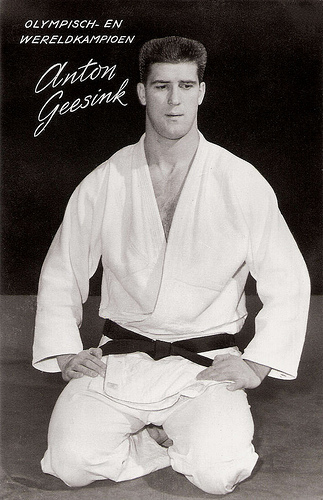
Dutch postcard by 't Sticht, Utrecht, no. 6040. Photo: J.J. Herschel jr.

Dutch postcard by 't Sticht, Utrecht, no. 6049.
Samson
Antonius Johannes Geesink was born in Utrecht, The Netherlands in 1934. He first participated in the European Championships in 1951, and placed second in his category. The following year, he won his first European title. Through to 1967, twenty more European titles followed.
At the 1956 World Championships, Geesink was eliminated in the semi-finals against Yoshihiko Yoshimatsu. At the 1961 World Championships, Geesink became World Champion in the open class, defeating the Japanese champion Koji Sone. Japanese judokas had won all the World Championship titles contested up to that point.
Judo debuted as an official sport at the 1964 Summer Olympics, which were held in the sport's home country, Japan. Anton Geesink provided one of the surprises of the Games by winning the open class through defeat of Akio Kaminaga. Although Japan had won all other judo events, the loss of the blue riband open class saddened the hosts.
His reputation as a strongman won Geesink roles in a few European action films. He played a supporting part as a detective in the Dutch crime film Rififi in Amsterdam (Giovanni Korporaal, 1962) based on a novel by W.H. van Eemlandt. The film was a Dutch example of the Rififi films, a popular subgenre of the French cinema in the 1950s. These were fast moving crime films, full of familiar faces, fancy camera-work and a couple of laughs. ‘Rififi’ was French slang for 'trouble in the underworld'. At IMDb , Chip Douglas reviews the film: “The result is as much fun as a Roger Corman film from the same period, perhaps even a bit classier.”
Geesink then starred in an early Spaghetti Western, Oklahoma John (Jaime Jesús Balcázar, Roberto Bianchi Montero, 1965) with Sabine Bethmann. Geesinks’s best known film is probably the Italian peplum I Grandi Condottieri/Great Leaders of the Bible (Marcello Baldi, Francisco Pérez-Dolz, 1965) with Fernando Rey, in which Geesink starred as the biblical super hero Samson.
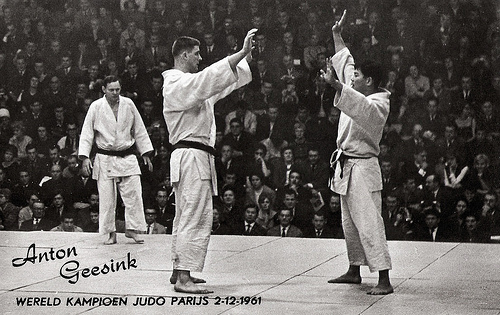
Dutch postcard by 't Sticht, Utrecht, no. AX 4884. Caption: Anton Geesink World Champion Judo Paris 2-12-1961. Tension during the match Anton Geesink - Koji Sone at the World Judo Championships in Paris.
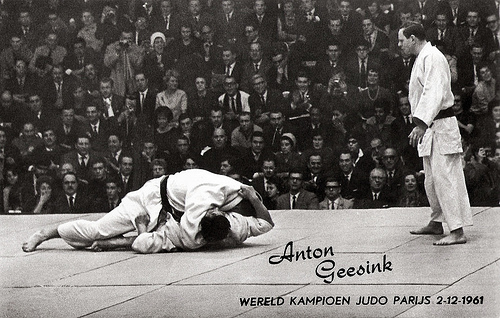
Dutch postcard by 't Sticht, Utrecht, no. AX 4886. Caption: Anton Geesink World Champion Judo Paris 2-12-1961.
This headlock during the match against Koji Sone made Anton Geesink Judo world champion during the world championships in Paris.
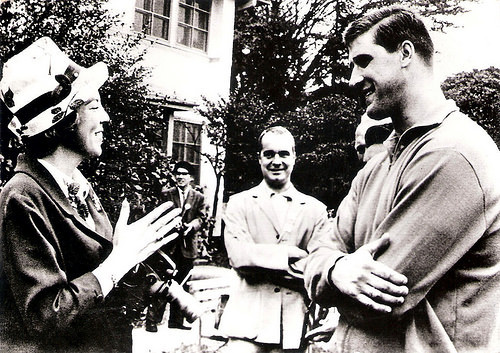
Dutch collectors card by Brio, no. 434, 1964. Caption: Princess Beatrix visited on the first day of her stay in Tokyo during the Games the Dutch department of the Olympic village and had a long and animated conversation with judo giant Anton Geesink.
Part-time Wrestler
After winning the 1965 World Championships and a last European title in 1967, Anton Geesink quit competitive judo. In October 1973, All Japan Pro Wrestling owner Giant Baba recruited Anton Geesink to join AJPW. Baba sent him to Amarillo, where TX, Dory Funk Jr. and Terry Funk trained him for a month. He worked for All Japan from 1973 to 1978, as a popular part-time wrestler.
Years after his short-lived film career, he re-appeared as an actor in some Dutch TV shows, such as the children’s series Pipo en de Noorderzon/Pipo and the Northern Sun (Wim Meuldijk, 1978) and the comedy series Zoals u wenst, mevrouw/As You Wish, Milady (Frans Boelen, 1984) with popular comedienne Carry Tefsen.
In 1986, Geesink was the first European judoka to receive the 9th-dan grade. A year later, he became a member of the board of the Dutch National Olympic Committee, and a member of the International Olympic Committee (IOC). In 1999, he was among the IOC members suspected of accepting bribes during the scandal surrounding the election of Salt Lake City as the host of the 2002 Winter Olympics. Geesink's name was cleared by the IOC which nevertheless issued him a warning for the appearance of a conflict of interest which could have damaged the reputation of the IOC.
His reputation as a sportsman was never damaged, and in 1997 he received the 10th-dan. This made him one of the highest graded judokas in the world. Only 18 people got ever a 10th-dan, and Geesink was one of the only three non-Japanese judokas who had this qualification. The International Judo Federation (IJF) placed him in their Hall of Fame in 2004.
At the age of 76, Anton Geesink died in 2010 in a hospital in his hometown Utrecht, where he lived above his own sports school in a street named after him, the Anton Geesinkstraat.
Anton Geesink at the 1961 World Championships. Source: beeld en geluid (YouTube).
With Anton Geesink 1962. Source: Tony Baretta (YouTube).
Scene from I Grandi Condottieri/Great Leaders of the Bible (1965). Source: Joe36Xcel (YouTube).
Sources: Sports-reference.com, Wikipedia (Dutch and English), and .

Dutch postcard by 't Sticht, Utrecht, no. AX 4883. Caption: Anton Geesink World Champion Judo Paris 2-12-1961.

Dutch postcard by 't Sticht, Utrecht, no. 6040. Photo: J.J. Herschel jr.

Dutch postcard by 't Sticht, Utrecht, no. 6049.
Samson
Antonius Johannes Geesink was born in Utrecht, The Netherlands in 1934. He first participated in the European Championships in 1951, and placed second in his category. The following year, he won his first European title. Through to 1967, twenty more European titles followed.
At the 1956 World Championships, Geesink was eliminated in the semi-finals against Yoshihiko Yoshimatsu. At the 1961 World Championships, Geesink became World Champion in the open class, defeating the Japanese champion Koji Sone. Japanese judokas had won all the World Championship titles contested up to that point.
Judo debuted as an official sport at the 1964 Summer Olympics, which were held in the sport's home country, Japan. Anton Geesink provided one of the surprises of the Games by winning the open class through defeat of Akio Kaminaga. Although Japan had won all other judo events, the loss of the blue riband open class saddened the hosts.
His reputation as a strongman won Geesink roles in a few European action films. He played a supporting part as a detective in the Dutch crime film Rififi in Amsterdam (Giovanni Korporaal, 1962) based on a novel by W.H. van Eemlandt. The film was a Dutch example of the Rififi films, a popular subgenre of the French cinema in the 1950s. These were fast moving crime films, full of familiar faces, fancy camera-work and a couple of laughs. ‘Rififi’ was French slang for 'trouble in the underworld'. At IMDb , Chip Douglas reviews the film: “The result is as much fun as a Roger Corman film from the same period, perhaps even a bit classier.”
Geesink then starred in an early Spaghetti Western, Oklahoma John (Jaime Jesús Balcázar, Roberto Bianchi Montero, 1965) with Sabine Bethmann. Geesinks’s best known film is probably the Italian peplum I Grandi Condottieri/Great Leaders of the Bible (Marcello Baldi, Francisco Pérez-Dolz, 1965) with Fernando Rey, in which Geesink starred as the biblical super hero Samson.

Dutch postcard by 't Sticht, Utrecht, no. AX 4884. Caption: Anton Geesink World Champion Judo Paris 2-12-1961. Tension during the match Anton Geesink - Koji Sone at the World Judo Championships in Paris.

Dutch postcard by 't Sticht, Utrecht, no. AX 4886. Caption: Anton Geesink World Champion Judo Paris 2-12-1961.
This headlock during the match against Koji Sone made Anton Geesink Judo world champion during the world championships in Paris.

Dutch collectors card by Brio, no. 434, 1964. Caption: Princess Beatrix visited on the first day of her stay in Tokyo during the Games the Dutch department of the Olympic village and had a long and animated conversation with judo giant Anton Geesink.
Part-time Wrestler
After winning the 1965 World Championships and a last European title in 1967, Anton Geesink quit competitive judo. In October 1973, All Japan Pro Wrestling owner Giant Baba recruited Anton Geesink to join AJPW. Baba sent him to Amarillo, where TX, Dory Funk Jr. and Terry Funk trained him for a month. He worked for All Japan from 1973 to 1978, as a popular part-time wrestler.
Years after his short-lived film career, he re-appeared as an actor in some Dutch TV shows, such as the children’s series Pipo en de Noorderzon/Pipo and the Northern Sun (Wim Meuldijk, 1978) and the comedy series Zoals u wenst, mevrouw/As You Wish, Milady (Frans Boelen, 1984) with popular comedienne Carry Tefsen.
In 1986, Geesink was the first European judoka to receive the 9th-dan grade. A year later, he became a member of the board of the Dutch National Olympic Committee, and a member of the International Olympic Committee (IOC). In 1999, he was among the IOC members suspected of accepting bribes during the scandal surrounding the election of Salt Lake City as the host of the 2002 Winter Olympics. Geesink's name was cleared by the IOC which nevertheless issued him a warning for the appearance of a conflict of interest which could have damaged the reputation of the IOC.
His reputation as a sportsman was never damaged, and in 1997 he received the 10th-dan. This made him one of the highest graded judokas in the world. Only 18 people got ever a 10th-dan, and Geesink was one of the only three non-Japanese judokas who had this qualification. The International Judo Federation (IJF) placed him in their Hall of Fame in 2004.
At the age of 76, Anton Geesink died in 2010 in a hospital in his hometown Utrecht, where he lived above his own sports school in a street named after him, the Anton Geesinkstraat.
Anton Geesink at the 1961 World Championships. Source: beeld en geluid (YouTube).
With Anton Geesink 1962. Source: Tony Baretta (YouTube).
Scene from I Grandi Condottieri/Great Leaders of the Bible (1965). Source: Joe36Xcel (YouTube).
Sources: Sports-reference.com, Wikipedia (Dutch and English), and .
Published on September 23, 2016 22:00
September 22, 2016
Truus van Aalten
Every year in early autumn, the Netherlands Film Festival (NFF) takes place. For ten days, the city of Utrecht is the cinema capital of the Netherlands, and we join the fun with our own Unofficial Dutch Film Star Postcards Festival (UDFSPF). Today's star is the 'Dutch Louise Brooks', Truus van Aalten (1910-1999). In the 1920s and early 1930s, she made 28 films in Germany and Austria, but only one in the Netherlands. The Germans lovingly called her die kleine holländische Käse (the little Dutch cheese).
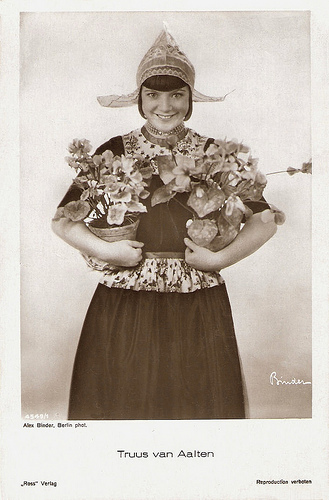
German postcard by Ross Verlag, no. 4549/1, 1929-1930. Photo: Alex Binder, Berlin.
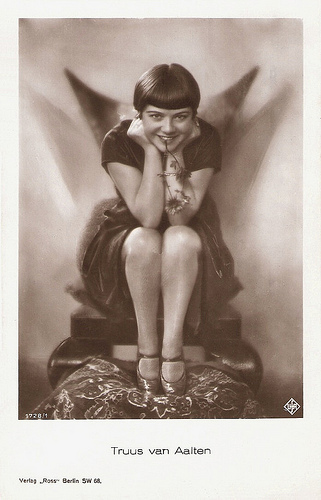
German postcard by Ross Verlag, no. 1720/1, 1927-1928. Photo: Ufa.
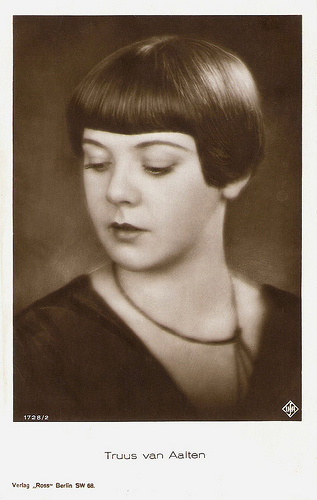
German postcard by Ross Verlag, no. 1728/2, 1927-1928. Photo: Ufa.
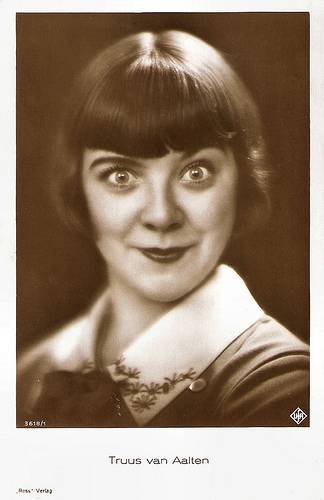
German postcard by Ross Verlag, no. 3618, 1928-1929. Photo: Ufa. Collection: Geoffrey Donaldson Institute.
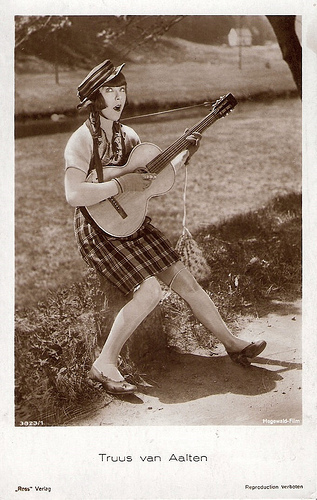
German postcard by Ross Verlag, no. 3823/1, 1928-1929. Photo: Hegewald Film. Collection: Geoffrey Donaldson Institute.
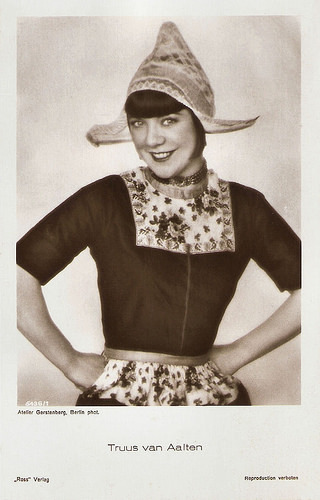
German postcard by Ross Verlag, no. 6436/1, 1931-1932. Photo: Atelier Gerstenberg, Berlin.
Film Metropolis Berlin
Geertruida Everdina Wilhelmina van Aalten was born in the city of Arnhem, in 1910. She was the daughter of high-street chemist Fransciscus (Frans) van Aalten and his wife Geertruida van den Anker.
Film crazy Truus was only sixteen when she won a competition by the Ufa in Dutch film magazine De Rolprent (The Moving Picture) in the summer of 1926. Soon she went to the film metropolis of Europe at the time: Berlin. By 1926, Universum Film A.G. (Ufa), was the main German film studio. From its Berlin studios at Neubabelsberg, Ufa had produced monumental films like Fritz Lang’s Die Nibelungen in 1923 and the Sci-Fi masterpiece Metropolis (Fritz Lang, 1926).
Truus' film was called Die sieben Töchter der Frau Gyurkovics/A Sister of Six (Ragnar Hyltén-Cavallius, 1927) and starred handsome idol Willy Fritsch . Her role was just a small, uncredited part. None of the other five unknown 'daughters' from Frau Gyurkovics would survive in the film industry, but the Ufa would soon realise that Truus was a gifted comedienne.
Truus returned to the Netherlands after the shooting of the film had finished. Only two days after she had returned home, a telegram arrived from the Ufa: IMMEDIATELY TO BERLIN - 3 YEAR CONTRACT. Truus had had no acting education at all, but she was sparkly and funny and the camera liked her. The Ufa put Truus into her next film - and she had a much bigger part now. Die Selige Exzellenz/His Holy Lordship (Adolf E. Licho, Wilhelm Thiele, 1927) was a comedy starring Willy Fritsch and Olga Tschechova .
Soon more small parts in other silent films followed, like in the romantic comedy Der moderne Casanova/A Modern Casanova (Max Obal, Rudolf Walther-Fein, 1928) with Harry Liedtke . Truus was often lent out to other film companies, and appeared in many cinema commercials and magazine promotions. Because of her informal acting and her humour, Truus' nickname in Germany became die kleine holländische Käse (the little Dutch cheese).
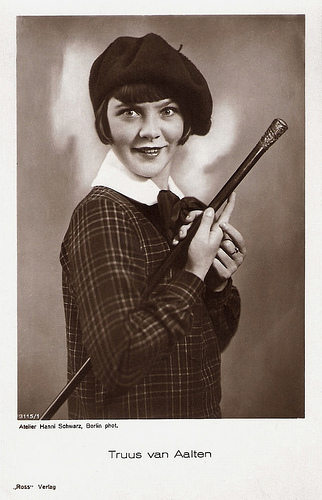
German postcard by Ross Verlag, no. 3115/1, 1928-1928. Photo: Hanni Schwarz, Berlin.
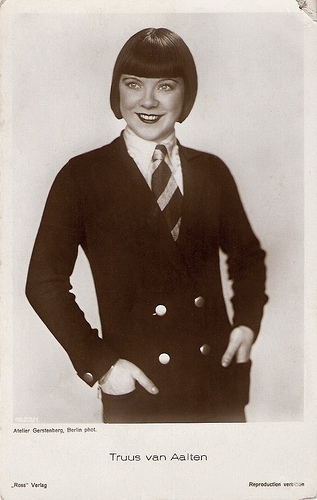
German postcard by Ross Verlag, no. 4029/1, 1929-1930. Photo: Gerstenberg, Berlin.

German postcard by Ross Verlag, no. 4184/1, 1929-1930. Photo: Atelier Binder, Berlin.
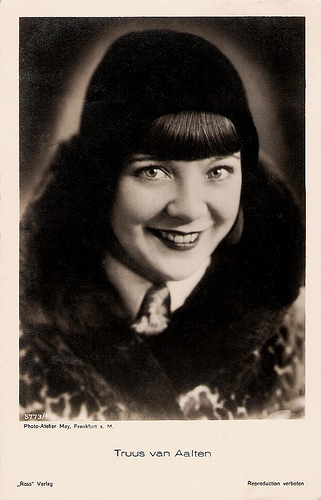
German postcard by Ross Verlag, no. 5773/1, 1930-1931. Photo: Photo-Atelier May, Frankfurt a.M.
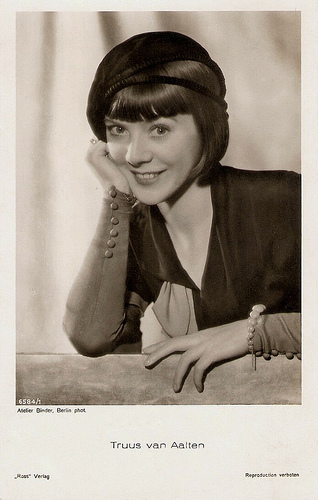
German postcard by Ross Verlag, no. 6584/1, 1931-1932. Photo: Atelier Binder, Berlin.
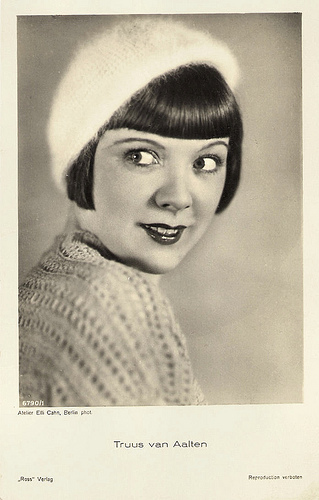
German postcard by Ross Verlag, no. 6790/1, 1931-1932. Photo: Eli Cahn, Berlin.
Backfish
Young and irreverent, Truus van Aalten became affectionately known in Germany as a Backfisch (literally meaning fish to fry). The new, 1920s girl was boyish yet feminine - short hair, gawky limbs, a young flapper on the edge of sexuality. Truus posed for photos and gave interviews for film magazines all over Europe. Truus even ended up in American movie magazines advertising Lux soap.
In 1929, Dutch director Jaap Speyer, took Truus back to the Netherlands to shoot scenes for Jenny's Bummel durch die Männer/Jenny's Stroll Through The Men (Jaap Speyer, 1929). News cameras caught up with the unit filming one sunny day on Scheveningen pier, and Dutch cinema audiences saw it all in their newsreels a few days later. Her next film, Der Sonderling/The Oddball (Walter Jerven, 1929) gave Truus the chance to work with the great comedian Karl Valentin as his cute and naughty counterpart.
The transition to the sound film turned out well for van Aalten despite her Dutch origin. Truus entered talking pictures by courtesy of experienced director Max Mack, who was about to shoot a new film starring Daisy d'Ora, Nur am Rhein.../Only On The Rhein... (Max Mack, 1930), and he wanted Truus to play Daisy's pal Lore. Mack signed her without requiring a microphone test - news of which spread around the film community like wildfire.
The public didn’t hold her Dutch accent against her. Truus was becoming really well known now - film magazines like Filmwoche and Filmwelt featured articles about das Mädchen aus Holland (that girl from Holland), Ross Verlag and other main publishers were issuing postcards of her. For the first time, she got top billing in the popular comedy Susanne macht Ordnung/Susanne Cleans Up (Eugen Thiele, 1930) in which she played a schoolgirl in search of her missing father.
Next she performed in such early sound films as Liebling der Götter/Darling of the Gods (Hanns Schwarz, 1930) with Emil Jannings , Pension Schöller (Georg Jacoby, 1930), and Kasernenzauber/Magic of the Barracks (Carl Boese, 1931) with Igo Sym .
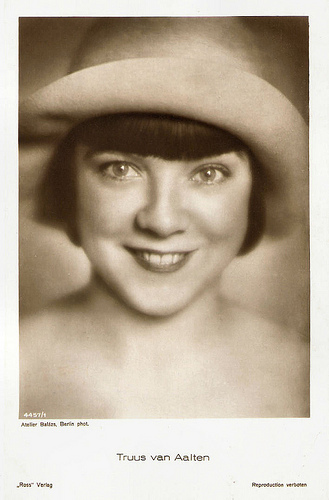
German postcard by Ross Verlag, no. 4457/1, 1929-1930. Photo: Atelier Balázs, Berlin.
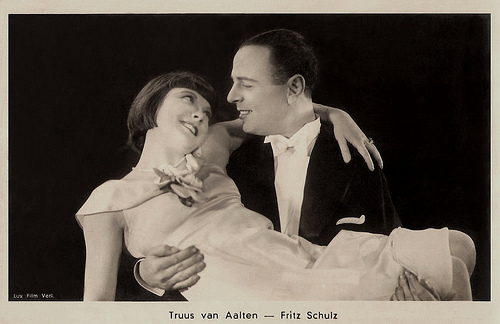
Austrian postcard by Iris-Verlag, no. 6538. Photo: Lux Film Verl. Publicity still for Der Bettelstudent/The Beggar Student (Victor Janson, 1931) with Fritz Schulz .
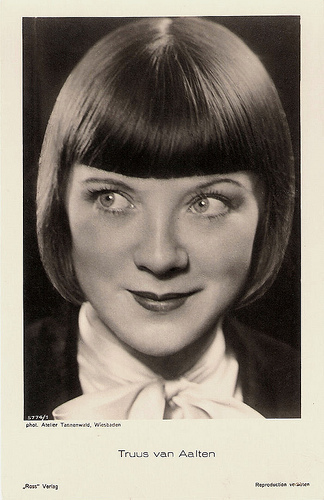
German postcard by Ross Verlag, no. 5774/1, 1930-1931. Photo: Atelier Tannenwald, Wiesbaden.
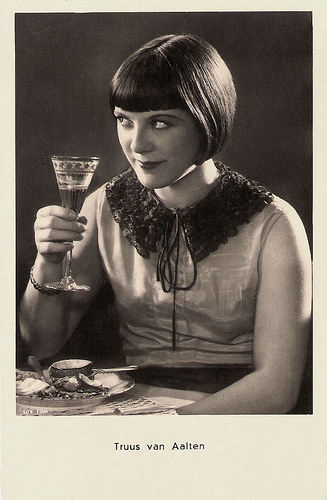
Austrian postcard by Iris Verlag, no. 6533. Photo: Lux Film.
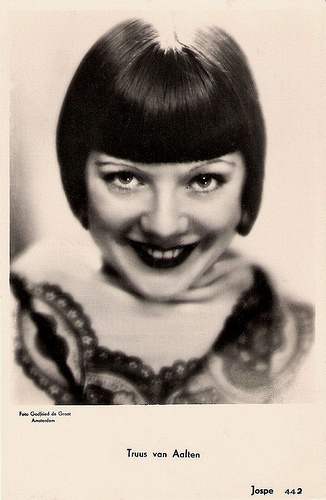
Dutch postcard by Jospe, no. 442. Photo by Godfried de Groot, Amsterdam.
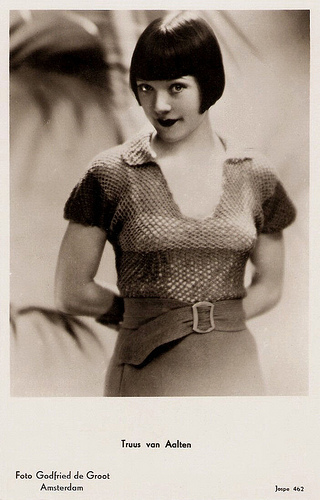
Dutch Postcard by JosPe, Arnhem, no. 462. Photo: Godfried de Groot, Amsterdam.
Souvenirs
By 1932, Truus van Aalten had outgrown her backfish image. She was a mature woman now, an experienced actress, but she was always typecast as a light comedy player. When the Nazis came to power, foreigners were subject to a quota system restricting how much they could work. Truus had not become a party member, and when the Nazis tried to use her in propaganda films, she refused.
Tired of the struggle to find work, she took the train and returned to Amsterdam. There, German director Georg Jacoby offered her a part in the Viennese operetta G'schichten aus dem Wienerwald/Tales From The Vienna Woods (Georg Jacoby, 1934), about an ordinary girl who swaps places with an American millionaire's daughter. In Austria, Magda Schneider was on board as the lead, and Truus played the rich girl. The successful film showed her new, mature look and her bleeched blonde hair.
Next van Aalten starred in the Dutch army comedy Het meisje met den blauwen hoed/The Girl with the Blue Hat (Rudolf Meinert, 1934) opposite Roland Varno . Although the film was a success in the Netherlands, it was not distributed abroad. Therefore Truus decided not to continue working in the young Dutch film industry.
After a long break, she got a role in Ein ganzer Kerl/A Regular Fellow (Fritz Peter Buch, 1939), a typical film of the Nazi era. Heidemarie Hatheyer played the lead as Jule, a strong, self willed woman who refuses to be ruled by the men in her life. By the end of the film she has realised her wrong-headedness, swapped her riding pants for a pretty dress and become the housewife she was destined to be. Truus played a character called Anni, a widow, and brought vivacity and humour to the part. Ein ganzer Kerl had its premiere in Berlin in January 1940. It would be Truus' last film.
After the war she tried to gain a foothold in Hollywood and in the British film business, but the there unknown actress finally failed because of her lack of knowledge of the English language. In the 1950s she became a businesswoman with a wholesale business importing and exporting Dutch souvenirs and promotional items, and in 1964 she married her employee Henk Godwaldt. Her last years were marred by mental illness.
Truus van Aalten died in the city of Warmond, the Netherlands, in 1999. Her archive has been donated to the Dutch Film Museum (now Eye Institute) in Amsterdam.
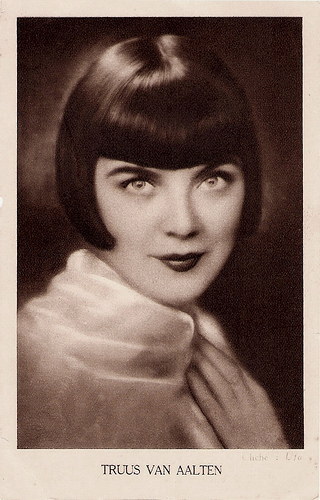
Dutch postcard especially printed for N.V. De Faam, P.A. de Bont's chocolate and sweets factory, Breda. Photo: Ufa.
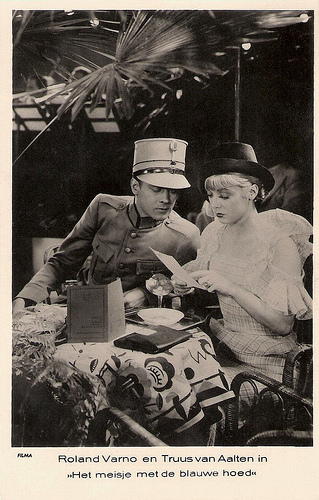
Dutch postcard by M. B. & Z. (M. Bonnist & Zonen, Amsterdam). Photo: Filma. Publicity still for Het Meisje met de Blauwe Hoed/The girl with the blue Hat (Rudolf Meinert, 1934) with Roland Varno .
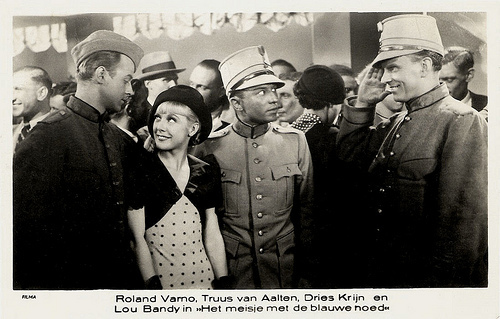
Dutch postcard by M. B.& Z. (M. Bonnist & Zonen, Amsterdam). Photo: Filma. Publicity still for Het Meisje met de Blauwe Hoed/The girl with the blue Hat (Rudolf Meinert, 1934) with Roland Varno , Dries Krijn and Lou Bandy .
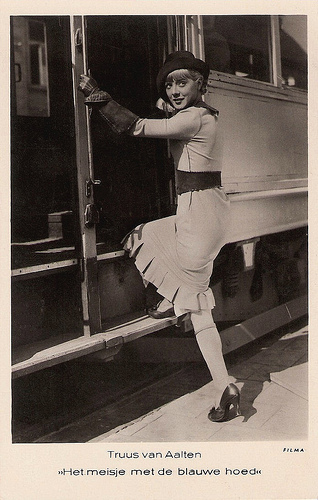
Dutch postcard by M. B. & Z. (M. Bonnist & Zonen, Amsterdam). Photo: Filma. Publicity still for Het meisje met den blauwen hoed/The girl with the blue Hat (Rudolf Meinert, 1934). Collection: Geoffrey Donaldson Institute.
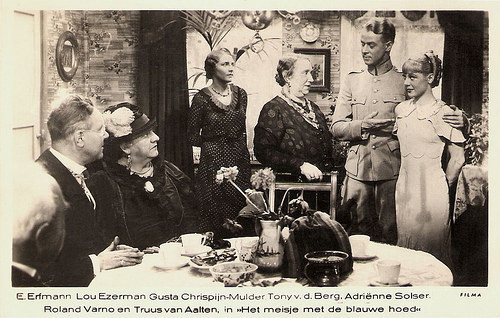
Dutch postcard by M. B. & Z. (M. Bonnist & Zonen, Amsterdam). Photo: Filma. Publicity still for Het Meisje met de Blauwe Hoed/The girl with the blue Hat (Rudolf Meinert, 1934) with Lau Ezerman , Gusta Chrispijn-Mulder , Tony van den Berg, Adriënne Solser and Roland Varno .

Dutch postcard by M. B. & Z. (M. Bonnist & Zonen, Amsterdam). Photo: Filma. Publicity still for Het Meisje met de Blauwe Hoed/The girl with the blue Hat (Rudolf Meinert, 1934).
Sources: Roger Mitchell (Truus van Aalten), Thomas Staedeli (Cyranos), Wikipedia (English and Dutch) and .

German postcard by Ross Verlag, no. 4549/1, 1929-1930. Photo: Alex Binder, Berlin.

German postcard by Ross Verlag, no. 1720/1, 1927-1928. Photo: Ufa.

German postcard by Ross Verlag, no. 1728/2, 1927-1928. Photo: Ufa.

German postcard by Ross Verlag, no. 3618, 1928-1929. Photo: Ufa. Collection: Geoffrey Donaldson Institute.

German postcard by Ross Verlag, no. 3823/1, 1928-1929. Photo: Hegewald Film. Collection: Geoffrey Donaldson Institute.

German postcard by Ross Verlag, no. 6436/1, 1931-1932. Photo: Atelier Gerstenberg, Berlin.
Film Metropolis Berlin
Geertruida Everdina Wilhelmina van Aalten was born in the city of Arnhem, in 1910. She was the daughter of high-street chemist Fransciscus (Frans) van Aalten and his wife Geertruida van den Anker.
Film crazy Truus was only sixteen when she won a competition by the Ufa in Dutch film magazine De Rolprent (The Moving Picture) in the summer of 1926. Soon she went to the film metropolis of Europe at the time: Berlin. By 1926, Universum Film A.G. (Ufa), was the main German film studio. From its Berlin studios at Neubabelsberg, Ufa had produced monumental films like Fritz Lang’s Die Nibelungen in 1923 and the Sci-Fi masterpiece Metropolis (Fritz Lang, 1926).
Truus' film was called Die sieben Töchter der Frau Gyurkovics/A Sister of Six (Ragnar Hyltén-Cavallius, 1927) and starred handsome idol Willy Fritsch . Her role was just a small, uncredited part. None of the other five unknown 'daughters' from Frau Gyurkovics would survive in the film industry, but the Ufa would soon realise that Truus was a gifted comedienne.
Truus returned to the Netherlands after the shooting of the film had finished. Only two days after she had returned home, a telegram arrived from the Ufa: IMMEDIATELY TO BERLIN - 3 YEAR CONTRACT. Truus had had no acting education at all, but she was sparkly and funny and the camera liked her. The Ufa put Truus into her next film - and she had a much bigger part now. Die Selige Exzellenz/His Holy Lordship (Adolf E. Licho, Wilhelm Thiele, 1927) was a comedy starring Willy Fritsch and Olga Tschechova .
Soon more small parts in other silent films followed, like in the romantic comedy Der moderne Casanova/A Modern Casanova (Max Obal, Rudolf Walther-Fein, 1928) with Harry Liedtke . Truus was often lent out to other film companies, and appeared in many cinema commercials and magazine promotions. Because of her informal acting and her humour, Truus' nickname in Germany became die kleine holländische Käse (the little Dutch cheese).

German postcard by Ross Verlag, no. 3115/1, 1928-1928. Photo: Hanni Schwarz, Berlin.

German postcard by Ross Verlag, no. 4029/1, 1929-1930. Photo: Gerstenberg, Berlin.

German postcard by Ross Verlag, no. 4184/1, 1929-1930. Photo: Atelier Binder, Berlin.

German postcard by Ross Verlag, no. 5773/1, 1930-1931. Photo: Photo-Atelier May, Frankfurt a.M.

German postcard by Ross Verlag, no. 6584/1, 1931-1932. Photo: Atelier Binder, Berlin.

German postcard by Ross Verlag, no. 6790/1, 1931-1932. Photo: Eli Cahn, Berlin.
Backfish
Young and irreverent, Truus van Aalten became affectionately known in Germany as a Backfisch (literally meaning fish to fry). The new, 1920s girl was boyish yet feminine - short hair, gawky limbs, a young flapper on the edge of sexuality. Truus posed for photos and gave interviews for film magazines all over Europe. Truus even ended up in American movie magazines advertising Lux soap.
In 1929, Dutch director Jaap Speyer, took Truus back to the Netherlands to shoot scenes for Jenny's Bummel durch die Männer/Jenny's Stroll Through The Men (Jaap Speyer, 1929). News cameras caught up with the unit filming one sunny day on Scheveningen pier, and Dutch cinema audiences saw it all in their newsreels a few days later. Her next film, Der Sonderling/The Oddball (Walter Jerven, 1929) gave Truus the chance to work with the great comedian Karl Valentin as his cute and naughty counterpart.
The transition to the sound film turned out well for van Aalten despite her Dutch origin. Truus entered talking pictures by courtesy of experienced director Max Mack, who was about to shoot a new film starring Daisy d'Ora, Nur am Rhein.../Only On The Rhein... (Max Mack, 1930), and he wanted Truus to play Daisy's pal Lore. Mack signed her without requiring a microphone test - news of which spread around the film community like wildfire.
The public didn’t hold her Dutch accent against her. Truus was becoming really well known now - film magazines like Filmwoche and Filmwelt featured articles about das Mädchen aus Holland (that girl from Holland), Ross Verlag and other main publishers were issuing postcards of her. For the first time, she got top billing in the popular comedy Susanne macht Ordnung/Susanne Cleans Up (Eugen Thiele, 1930) in which she played a schoolgirl in search of her missing father.
Next she performed in such early sound films as Liebling der Götter/Darling of the Gods (Hanns Schwarz, 1930) with Emil Jannings , Pension Schöller (Georg Jacoby, 1930), and Kasernenzauber/Magic of the Barracks (Carl Boese, 1931) with Igo Sym .

German postcard by Ross Verlag, no. 4457/1, 1929-1930. Photo: Atelier Balázs, Berlin.

Austrian postcard by Iris-Verlag, no. 6538. Photo: Lux Film Verl. Publicity still for Der Bettelstudent/The Beggar Student (Victor Janson, 1931) with Fritz Schulz .

German postcard by Ross Verlag, no. 5774/1, 1930-1931. Photo: Atelier Tannenwald, Wiesbaden.

Austrian postcard by Iris Verlag, no. 6533. Photo: Lux Film.

Dutch postcard by Jospe, no. 442. Photo by Godfried de Groot, Amsterdam.

Dutch Postcard by JosPe, Arnhem, no. 462. Photo: Godfried de Groot, Amsterdam.
Souvenirs
By 1932, Truus van Aalten had outgrown her backfish image. She was a mature woman now, an experienced actress, but she was always typecast as a light comedy player. When the Nazis came to power, foreigners were subject to a quota system restricting how much they could work. Truus had not become a party member, and when the Nazis tried to use her in propaganda films, she refused.
Tired of the struggle to find work, she took the train and returned to Amsterdam. There, German director Georg Jacoby offered her a part in the Viennese operetta G'schichten aus dem Wienerwald/Tales From The Vienna Woods (Georg Jacoby, 1934), about an ordinary girl who swaps places with an American millionaire's daughter. In Austria, Magda Schneider was on board as the lead, and Truus played the rich girl. The successful film showed her new, mature look and her bleeched blonde hair.
Next van Aalten starred in the Dutch army comedy Het meisje met den blauwen hoed/The Girl with the Blue Hat (Rudolf Meinert, 1934) opposite Roland Varno . Although the film was a success in the Netherlands, it was not distributed abroad. Therefore Truus decided not to continue working in the young Dutch film industry.
After a long break, she got a role in Ein ganzer Kerl/A Regular Fellow (Fritz Peter Buch, 1939), a typical film of the Nazi era. Heidemarie Hatheyer played the lead as Jule, a strong, self willed woman who refuses to be ruled by the men in her life. By the end of the film she has realised her wrong-headedness, swapped her riding pants for a pretty dress and become the housewife she was destined to be. Truus played a character called Anni, a widow, and brought vivacity and humour to the part. Ein ganzer Kerl had its premiere in Berlin in January 1940. It would be Truus' last film.
After the war she tried to gain a foothold in Hollywood and in the British film business, but the there unknown actress finally failed because of her lack of knowledge of the English language. In the 1950s she became a businesswoman with a wholesale business importing and exporting Dutch souvenirs and promotional items, and in 1964 she married her employee Henk Godwaldt. Her last years were marred by mental illness.
Truus van Aalten died in the city of Warmond, the Netherlands, in 1999. Her archive has been donated to the Dutch Film Museum (now Eye Institute) in Amsterdam.

Dutch postcard especially printed for N.V. De Faam, P.A. de Bont's chocolate and sweets factory, Breda. Photo: Ufa.

Dutch postcard by M. B. & Z. (M. Bonnist & Zonen, Amsterdam). Photo: Filma. Publicity still for Het Meisje met de Blauwe Hoed/The girl with the blue Hat (Rudolf Meinert, 1934) with Roland Varno .

Dutch postcard by M. B.& Z. (M. Bonnist & Zonen, Amsterdam). Photo: Filma. Publicity still for Het Meisje met de Blauwe Hoed/The girl with the blue Hat (Rudolf Meinert, 1934) with Roland Varno , Dries Krijn and Lou Bandy .

Dutch postcard by M. B. & Z. (M. Bonnist & Zonen, Amsterdam). Photo: Filma. Publicity still for Het meisje met den blauwen hoed/The girl with the blue Hat (Rudolf Meinert, 1934). Collection: Geoffrey Donaldson Institute.

Dutch postcard by M. B. & Z. (M. Bonnist & Zonen, Amsterdam). Photo: Filma. Publicity still for Het Meisje met de Blauwe Hoed/The girl with the blue Hat (Rudolf Meinert, 1934) with Lau Ezerman , Gusta Chrispijn-Mulder , Tony van den Berg, Adriënne Solser and Roland Varno .

Dutch postcard by M. B. & Z. (M. Bonnist & Zonen, Amsterdam). Photo: Filma. Publicity still for Het Meisje met de Blauwe Hoed/The girl with the blue Hat (Rudolf Meinert, 1934).
Sources: Roger Mitchell (Truus van Aalten), Thomas Staedeli (Cyranos), Wikipedia (English and Dutch) and .
Published on September 22, 2016 22:00
Happy 75, Anna Karina!
Today is the birthday of the queen of the Nouvelle Vague, film actress, singer and director Anna Karina (1940). French, but Danish-born Karina was the muse of director Jean-Luc Godard and starred in eight of his films.

French postcard by E.D.U.G., no. 471. Photo: Sam Lévin.
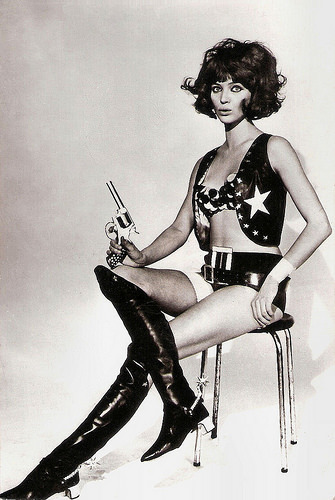
Romanian postcard by Casa Filmului Acin, no. 209.
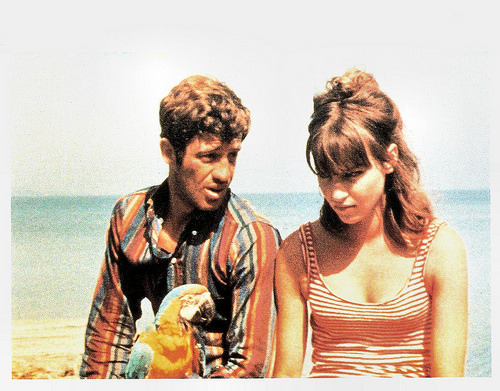
French postcard by La Cinémathèque française, no. CF 5006, 1998. Photo: UGC Da International. Publicity still for Pierrot le fou (Jean-Luc Godard, 1965).
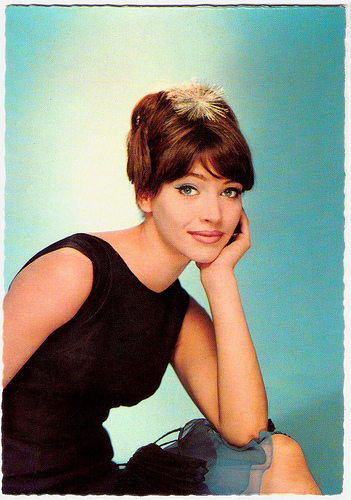
French postcard by E.D.U.G., Paris, no. 181, 1969. Photo: Sam Lévin.
Fashion Model
Anna Karina was born Hanne Karen Blarke Bayer in Solbjerg, Denmark, in 1940. Her mother was a dress shop owner and her father a ship's captain. Before she turned one, her father had left her mother.
First she was raised by her maternal grandparents, where she stayed until the age of four. Then she spent time in and out of foster homes, before returning to live with her mother from the age of eight.
She has described her childhood as 'terribly wanting to be loved' and as a child, she made numerous attempts to run away from home.
She began her career in Denmark, where she sang in cabarets and worked as a model playing in commercials. At age 14, she appeared in the Danish short film Pigen og skoene/Girls and Shoes (Ib Schedes, 1954), which won a prize at the Cannes Film Festival. She studied dance and painting in Denmark and for a while made a living selling her paintings.
In 1958, after a row with her mother, she hitchhiked to Paris. She had a break when, sitting briefly at the cafe Les Deux Magots, she was approached by a woman from an advertisement agency who asked her to do some photos. Hanne became a rising fashion model, and met Coco Chanel and Pierre Cardin. Chanel advised her to use as a professional name Anna Karina.
She made a series of Palmolive ads in a bath covered in soapsuds, and was noticed by Jean-Luc Godard, then a film critic for Cahiers du cinéma. Godard was casting his debut feature film, À bout de souffle/Breathless (1960) starring Jean-Paul Belmondo . He offered her a small role, but she refused when he mentioned that there would be a nude scene.
However, she eventually accepted his offer to play a major role in his second film, Le Petit Soldat/The Little Soldier (1960) with Michel Subor. Karina, who was still under 21 had to persuade her estranged mother to sign the contract for her.
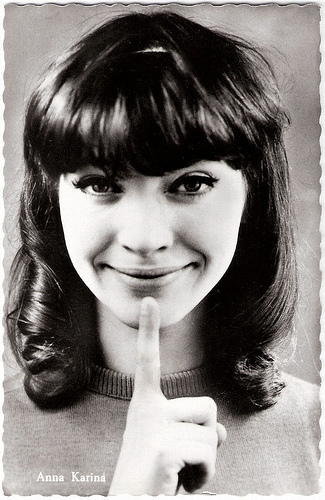
Dutch postcard by Hafbo film, no. 162. Photo: publicity still for Une femme est une femme/A Woman Is a Woman (Jean-Luc Godard, 1961).
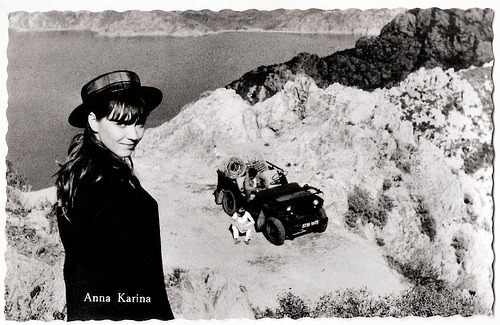
Dutch postcard by N.V. v.h. Weenenk & Snel, Baarn, no. 853. Photo: Hafbo-film. Publicity still for Le soleil dans l'oeil/Sun in Your Eyes (Jacques Bourdon, 1962).
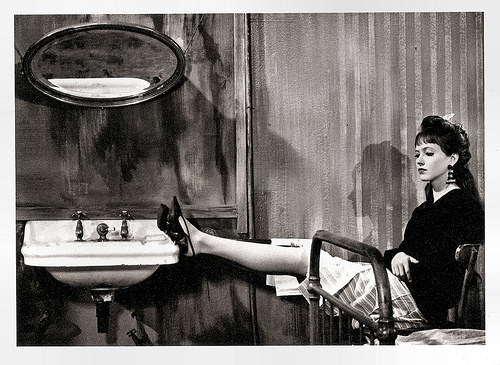
French postcard by Edition Librairie de la Fontaine, Paris, no. 5 (Tirage limité à 250 exemplaires). Photo: Claude Schwartz / Spadem, Paris. Caption: Anna Karina, 1963.
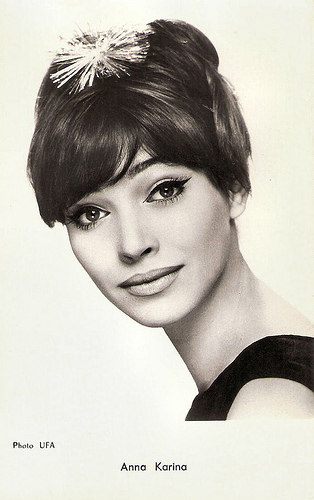
French postcard by Editions P.I., Paris, no. FK 110. Photo: Ufa.
Nouvelle Vague
Anna Karina and Jean-Luc Godard married during the shooting of their next film, Une femme est une femme/A Woman Is a Woman (1961) with Jean-Paul Belmondo and Jean-Claude Brialy . It is a tribute to American musical comedy and the first film Godard shot in color and Cinemascope.
Judd Blaise at AllMovie : "Rather than the sometimes alienating, dense intellectualism of later Godard works, Une femme est une femme offers aesthetic pleasure through luxurious visuals and a charming musical score by Michel Legrand. Against this bright backdrop, Karina proves particularly fetching, capturing the film's frolicsome mood in an unforced manner. While not one of Godard's most groundbreaking or influential films, Une femme est une femme is one of his most appealing and pleasurable efforts."
J. Hoberman at Criterion: "Mainly, A Woman Is a Woman is a valentine to Karina, who became pregnant during the course of the movie’s production; she and Godard were married in March 1961, an event that made the cover of Paris Match." At the Berlin Film Festival in 1961, Anna Karina was awarded as Best Actress for Une femme est une femme.
In the following years, the couple made Vivre sa Vie/My Life to Live (1962), Bande à part/Band of Outsiders (1964), Alphaville, une étrange aventure de Lemmy Caution/Alphaville, a Strange Adventure of Lemmy Caution (1965) with Eddie Constantine , Pierrot le fou/Pierrot Goes Wild (1965) with Jean-Paul Belmondo , Made in U.S.A. (1966) with Jean-Pierre Léaud and the anthology film Le plus vieux métier du monde/The Oldest Profession (1967).
Though their cinematic collaboration seemed harmonious, behind the scenes, their relationship was tumultuous and bitter, made all the more difficult by the fact that it was under constant public scrutiny. Their three-year marriage ended in 1964, though they continued to work together until 1966. In 1967, Godard and Karina divorced.
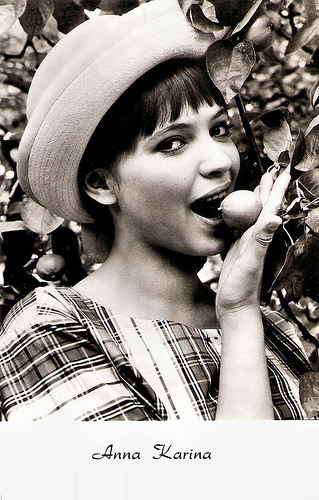
Dutch postcard by Gebr. Spanjersberg N.V, Rotterdam, no. 6099. Photo: Combi Press, Amsterdam.
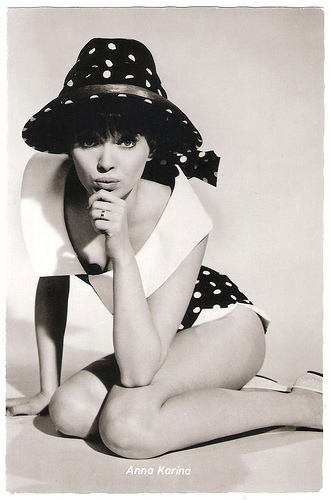
German postcard by Kolibri-Verlag G.m.b.H., Minden-Westf., no. 1872.
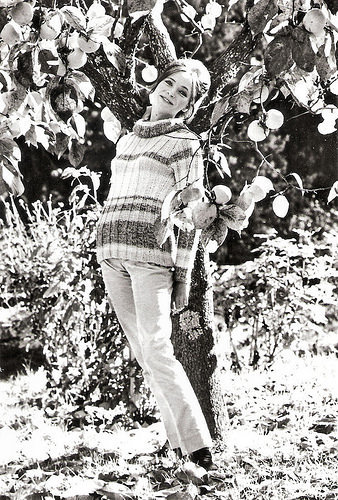
Romanian postcard by Casa Filmului Acin, no. 133.
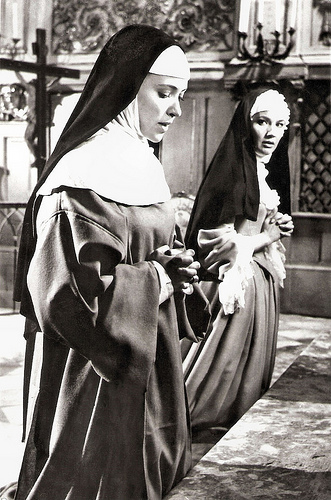
Romanian postcard by Casa Filmului Acin, no. 265. Photo: publicity still for La Religieuse/The Nun (Jacques Rivette, 1966).
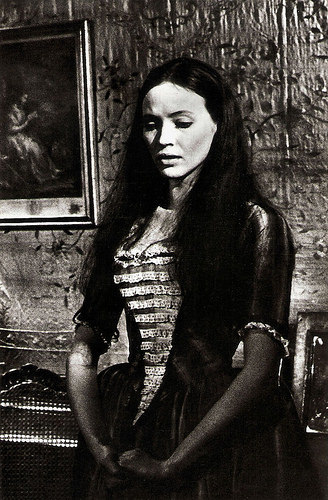
Romanian postcard by Casa Filmului Acin, no. 330. Photo: publicity still for La Religieuse/The Nun (Jacques Rivette, 1966).
Hollywood
Hal Erickson at AllMovie : "From all reports, Karina and Godard's relationship was symbiotic; it is certainly no coincidence that both actress and director went into a temporary artistic eclipse after their 1967 breakup."
Anna Karina's acting career was not, however, limited to Godard's films, and she had a successful collaboration with other well-known directors. Some consider as her best performance her role in La Religieuse/The Nun (Jacques Rivette, 1966) in which she plays an intelligent, freedom-loving woman who is forced into a convent against her will.
She also acted in the Italian productions Le Soldatesse/The Camp Followers (Valerio Zurlini, 1965) and the Albert Camus adaptation Lo Straniero/The Stranger (Luchino Visconti, 1967) starring Marcello Mastroianni .
Karina also maintained a singing career and scored hits with Sous le soleil exactement and Roller Girl. Both songs were taken from the TV musical Anna (Pierre Koralnik, 1967), which Serge Gainsbourg had especially written for her.
After her divorce in 1967 she went to Hollywood. She acted in Justine (George Cukor, 1969) and returned to Paris. Her later films included Laughter in the Dark (Tony Richardson, 1969), Rendez-vous à Bray/Appointment in Bray (André Delvaux, 1971) with Mathieu Carrière, Pane e cioccolata/Bread and Chocolate (Franco Brusati, 1973) starring Nino Manfredi , Chinesisches Roulette/Chinese Roulette (Rainer Werner Fassbinder, 1976), and Olyan mint otthon/Just Like Home (Márta Mészáros, 1978) with Jan Nowicki.
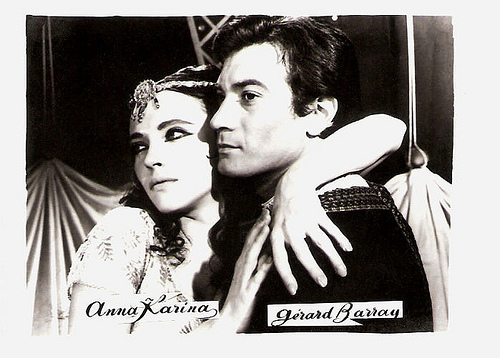
Small Romanian collector's card. Photo: publicity still for Sheherazade (Pierre-Gaspard-Huit, 1963) with Gérard Barray.
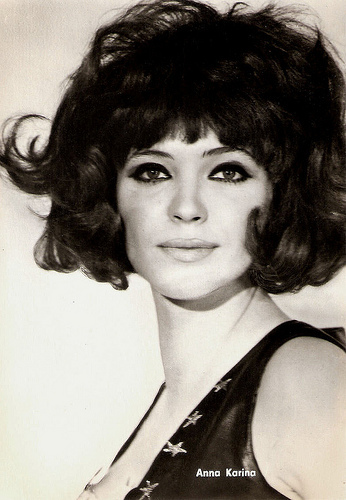
East-German postcard by VEB Progress Filmvertrieb, Berlin, no. 177/69, 1969. Retail price: 0,20 M. Photo: Unifrance Film.
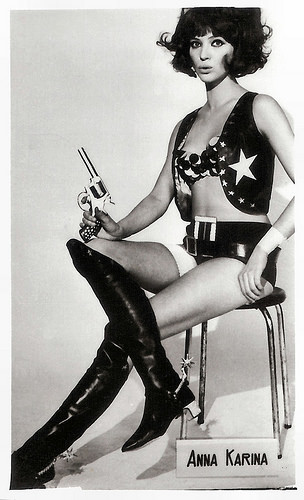
Small Romanian collectors card by Cooperativa Fotografia, no. 10.
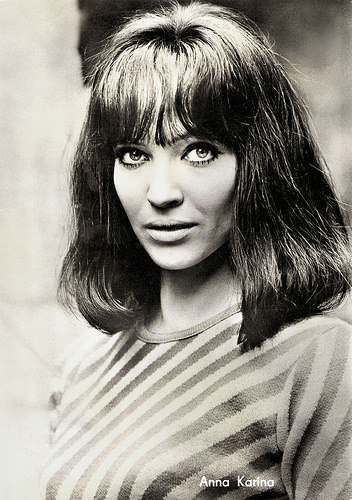
Big East-German card by VEB Progress Filmvertrieb, Berlin, no. 6/71. Photo: Unifrance Film.
Chansons de films
Anna Karina acted in but also wrote, produced and directed Vivre ensemble/Living Together (1973). She has also written three novels and made several appearances on television. She appeared on stage in Jacques Rivette's adaptation of La Religieuse/The Nun, Pour Lucrece, Toi et Tes Nuages, Francoise Sagan's Il Fait Beau Jour et Nuit and Ingmar Bergman's Apres La Répétition/After the Repetition.
In 2005 she released Chansons de films, a collection of songs sung in films. Incidentally she played in films like L'oeuvre au noir/The Abyss (André Delvaux, 1988) with Gian Maria Volonté, Haut bas fragile/Up, Down, Fragile (Jacques Rivette, 1995) and the romantic thriller The Truth About Charlie (Jonathan Demme, 2002) starring Mark Wahlberg.
James Travers at Le Film Site on L'oeuvre au noir/The Abyss : "This sombre adaptation of Marguerite Yourcenar’s acclaimed literary work was directed by the acclaimed Belgian film-maker André Delvaux. Visually, the film is impressive and it boasts an excellent cast, but for all its excellent production values it is a heavy and somewhat laboured affair."
Karina's most recent film as a director was Victoria (2008) in which she also starred. Mark Deming at AllMovie : "Thirty-five years after directing her first feature film, iconic actress Anna Karina once again steps behind the camera for this charming comedy-drama shot in Canada. Jimmy (Emmanuel Reichenbach) and Stanislas (Jean-Francois Moran) are a pair of nightclub performers who play second-rate gay nightclubs as part of a drag act called 'Les Lolitas'."
After Godard, Anna Karina was married three times more: to scriptwriter-actor Pierre Fabre (1968–1973), actor-director Daniel Duval (1978–1981) and director Dennis Berry (1982–1994). Since 2009 she is married to Maurice Cooks.
Scenes from Vivre sa vie (1962). Source: Paulo A (YouTube).
Anna Karina sings Jamais je ne t'ai dit que je t'aimerai toujours in Pierrot le Fou (1965) with Jean-Paul Belmondo. Source: Tobe Auster (YouTube).
Trailer Made in U.S.A. (1966). Source: Danios 12345 (YouTube).
Japanese trailer Anna (1967). Source: Night of the Trailers (YouTube).
Sources: Judd Blaise (AllMovie), J. Hoberman (Criterion), James Travers (Le Film Guide), Mark Deming (AllMovie), Hal Erickson (AllMovie), Fuck yeah! Anna Karina, and Wikipedia.

French postcard by E.D.U.G., no. 471. Photo: Sam Lévin.

Romanian postcard by Casa Filmului Acin, no. 209.

French postcard by La Cinémathèque française, no. CF 5006, 1998. Photo: UGC Da International. Publicity still for Pierrot le fou (Jean-Luc Godard, 1965).

French postcard by E.D.U.G., Paris, no. 181, 1969. Photo: Sam Lévin.
Fashion Model
Anna Karina was born Hanne Karen Blarke Bayer in Solbjerg, Denmark, in 1940. Her mother was a dress shop owner and her father a ship's captain. Before she turned one, her father had left her mother.
First she was raised by her maternal grandparents, where she stayed until the age of four. Then she spent time in and out of foster homes, before returning to live with her mother from the age of eight.
She has described her childhood as 'terribly wanting to be loved' and as a child, she made numerous attempts to run away from home.
She began her career in Denmark, where she sang in cabarets and worked as a model playing in commercials. At age 14, she appeared in the Danish short film Pigen og skoene/Girls and Shoes (Ib Schedes, 1954), which won a prize at the Cannes Film Festival. She studied dance and painting in Denmark and for a while made a living selling her paintings.
In 1958, after a row with her mother, she hitchhiked to Paris. She had a break when, sitting briefly at the cafe Les Deux Magots, she was approached by a woman from an advertisement agency who asked her to do some photos. Hanne became a rising fashion model, and met Coco Chanel and Pierre Cardin. Chanel advised her to use as a professional name Anna Karina.
She made a series of Palmolive ads in a bath covered in soapsuds, and was noticed by Jean-Luc Godard, then a film critic for Cahiers du cinéma. Godard was casting his debut feature film, À bout de souffle/Breathless (1960) starring Jean-Paul Belmondo . He offered her a small role, but she refused when he mentioned that there would be a nude scene.
However, she eventually accepted his offer to play a major role in his second film, Le Petit Soldat/The Little Soldier (1960) with Michel Subor. Karina, who was still under 21 had to persuade her estranged mother to sign the contract for her.

Dutch postcard by Hafbo film, no. 162. Photo: publicity still for Une femme est une femme/A Woman Is a Woman (Jean-Luc Godard, 1961).

Dutch postcard by N.V. v.h. Weenenk & Snel, Baarn, no. 853. Photo: Hafbo-film. Publicity still for Le soleil dans l'oeil/Sun in Your Eyes (Jacques Bourdon, 1962).

French postcard by Edition Librairie de la Fontaine, Paris, no. 5 (Tirage limité à 250 exemplaires). Photo: Claude Schwartz / Spadem, Paris. Caption: Anna Karina, 1963.

French postcard by Editions P.I., Paris, no. FK 110. Photo: Ufa.
Nouvelle Vague
Anna Karina and Jean-Luc Godard married during the shooting of their next film, Une femme est une femme/A Woman Is a Woman (1961) with Jean-Paul Belmondo and Jean-Claude Brialy . It is a tribute to American musical comedy and the first film Godard shot in color and Cinemascope.
Judd Blaise at AllMovie : "Rather than the sometimes alienating, dense intellectualism of later Godard works, Une femme est une femme offers aesthetic pleasure through luxurious visuals and a charming musical score by Michel Legrand. Against this bright backdrop, Karina proves particularly fetching, capturing the film's frolicsome mood in an unforced manner. While not one of Godard's most groundbreaking or influential films, Une femme est une femme is one of his most appealing and pleasurable efforts."
J. Hoberman at Criterion: "Mainly, A Woman Is a Woman is a valentine to Karina, who became pregnant during the course of the movie’s production; she and Godard were married in March 1961, an event that made the cover of Paris Match." At the Berlin Film Festival in 1961, Anna Karina was awarded as Best Actress for Une femme est une femme.
In the following years, the couple made Vivre sa Vie/My Life to Live (1962), Bande à part/Band of Outsiders (1964), Alphaville, une étrange aventure de Lemmy Caution/Alphaville, a Strange Adventure of Lemmy Caution (1965) with Eddie Constantine , Pierrot le fou/Pierrot Goes Wild (1965) with Jean-Paul Belmondo , Made in U.S.A. (1966) with Jean-Pierre Léaud and the anthology film Le plus vieux métier du monde/The Oldest Profession (1967).
Though their cinematic collaboration seemed harmonious, behind the scenes, their relationship was tumultuous and bitter, made all the more difficult by the fact that it was under constant public scrutiny. Their three-year marriage ended in 1964, though they continued to work together until 1966. In 1967, Godard and Karina divorced.

Dutch postcard by Gebr. Spanjersberg N.V, Rotterdam, no. 6099. Photo: Combi Press, Amsterdam.

German postcard by Kolibri-Verlag G.m.b.H., Minden-Westf., no. 1872.

Romanian postcard by Casa Filmului Acin, no. 133.

Romanian postcard by Casa Filmului Acin, no. 265. Photo: publicity still for La Religieuse/The Nun (Jacques Rivette, 1966).

Romanian postcard by Casa Filmului Acin, no. 330. Photo: publicity still for La Religieuse/The Nun (Jacques Rivette, 1966).
Hollywood
Hal Erickson at AllMovie : "From all reports, Karina and Godard's relationship was symbiotic; it is certainly no coincidence that both actress and director went into a temporary artistic eclipse after their 1967 breakup."
Anna Karina's acting career was not, however, limited to Godard's films, and she had a successful collaboration with other well-known directors. Some consider as her best performance her role in La Religieuse/The Nun (Jacques Rivette, 1966) in which she plays an intelligent, freedom-loving woman who is forced into a convent against her will.
She also acted in the Italian productions Le Soldatesse/The Camp Followers (Valerio Zurlini, 1965) and the Albert Camus adaptation Lo Straniero/The Stranger (Luchino Visconti, 1967) starring Marcello Mastroianni .
Karina also maintained a singing career and scored hits with Sous le soleil exactement and Roller Girl. Both songs were taken from the TV musical Anna (Pierre Koralnik, 1967), which Serge Gainsbourg had especially written for her.
After her divorce in 1967 she went to Hollywood. She acted in Justine (George Cukor, 1969) and returned to Paris. Her later films included Laughter in the Dark (Tony Richardson, 1969), Rendez-vous à Bray/Appointment in Bray (André Delvaux, 1971) with Mathieu Carrière, Pane e cioccolata/Bread and Chocolate (Franco Brusati, 1973) starring Nino Manfredi , Chinesisches Roulette/Chinese Roulette (Rainer Werner Fassbinder, 1976), and Olyan mint otthon/Just Like Home (Márta Mészáros, 1978) with Jan Nowicki.

Small Romanian collector's card. Photo: publicity still for Sheherazade (Pierre-Gaspard-Huit, 1963) with Gérard Barray.

East-German postcard by VEB Progress Filmvertrieb, Berlin, no. 177/69, 1969. Retail price: 0,20 M. Photo: Unifrance Film.

Small Romanian collectors card by Cooperativa Fotografia, no. 10.

Big East-German card by VEB Progress Filmvertrieb, Berlin, no. 6/71. Photo: Unifrance Film.
Chansons de films
Anna Karina acted in but also wrote, produced and directed Vivre ensemble/Living Together (1973). She has also written three novels and made several appearances on television. She appeared on stage in Jacques Rivette's adaptation of La Religieuse/The Nun, Pour Lucrece, Toi et Tes Nuages, Francoise Sagan's Il Fait Beau Jour et Nuit and Ingmar Bergman's Apres La Répétition/After the Repetition.
In 2005 she released Chansons de films, a collection of songs sung in films. Incidentally she played in films like L'oeuvre au noir/The Abyss (André Delvaux, 1988) with Gian Maria Volonté, Haut bas fragile/Up, Down, Fragile (Jacques Rivette, 1995) and the romantic thriller The Truth About Charlie (Jonathan Demme, 2002) starring Mark Wahlberg.
James Travers at Le Film Site on L'oeuvre au noir/The Abyss : "This sombre adaptation of Marguerite Yourcenar’s acclaimed literary work was directed by the acclaimed Belgian film-maker André Delvaux. Visually, the film is impressive and it boasts an excellent cast, but for all its excellent production values it is a heavy and somewhat laboured affair."
Karina's most recent film as a director was Victoria (2008) in which she also starred. Mark Deming at AllMovie : "Thirty-five years after directing her first feature film, iconic actress Anna Karina once again steps behind the camera for this charming comedy-drama shot in Canada. Jimmy (Emmanuel Reichenbach) and Stanislas (Jean-Francois Moran) are a pair of nightclub performers who play second-rate gay nightclubs as part of a drag act called 'Les Lolitas'."
After Godard, Anna Karina was married three times more: to scriptwriter-actor Pierre Fabre (1968–1973), actor-director Daniel Duval (1978–1981) and director Dennis Berry (1982–1994). Since 2009 she is married to Maurice Cooks.
Scenes from Vivre sa vie (1962). Source: Paulo A (YouTube).
Anna Karina sings Jamais je ne t'ai dit que je t'aimerai toujours in Pierrot le Fou (1965) with Jean-Paul Belmondo. Source: Tobe Auster (YouTube).
Trailer Made in U.S.A. (1966). Source: Danios 12345 (YouTube).
Japanese trailer Anna (1967). Source: Night of the Trailers (YouTube).
Sources: Judd Blaise (AllMovie), J. Hoberman (Criterion), James Travers (Le Film Guide), Mark Deming (AllMovie), Hal Erickson (AllMovie), Fuck yeah! Anna Karina, and Wikipedia.
Published on September 22, 2016 00:00
September 21, 2016
Louis Borel
Every year in early autumn, the Dutch film industry and public gather at the Netherlands Film Festival (NFF) to see, assess, discuss and celebrate the Dutch cinema. From 21 till 30 September 2016, Utrecht is the capital of film, and at EFSP, Dutch cinema is also placed centre stage. Today, Dutch actor Louis Borel (1905-1973), who appeared in films in the Netherlands, in Great Britain and in Hollywood. He also adapted, translated, directed and starred in many stage plays. At the end of his career he became a popular star on Dutch television.
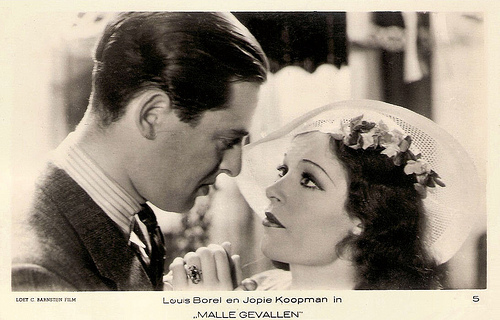
Dutch postcard by M. B.& Z. (M. Bonnist & Zonen, Amsterdam), no. 5. Photo: Loet C. Barnstijn Film. Still for Malle gevallen/Silly Situations (Jaap Speyer, 1934) with Jopie Koopman .
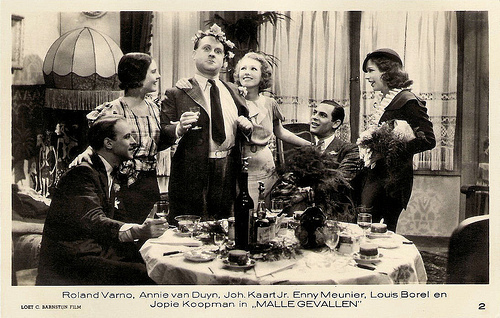
Dutch postcard by Loet C. Barnstijn Film, no. 2. Photo: still for Malle Gevallen/Silly Situations (1934). Collectie: Geoffrey Donaldson Institute.
Silly Situations
Louis Borel was born as Lodewijk Borel in Den Haag (The Hague), Netherlands in 1905. He was the son of author and journalist Henri Jean François Borel and his second wife Helena Maria de Hartog. He had two half-sisters and a half-brother. His father had destined Louis to become a banker but the boy chose otherwise.
In 1924, Louis started his stage career as Lodewijk Makkay at the company of legendary Dutch actor Cor van der Lugt Melsert. Next he worked at the Nederlands-Indisch Toneel (Dutch-Indonesian Theatre), led by Cor Ruys, which performed alternately in the Netherlands and the Dutch East Indies. In 1928 he worked with a theatre group which was led by Theo Frenkel jr.
In 1934 he made his film debut in the comedy Malle gevallen/Silly Situations (Jaap Speyer, 1934) based on a novel by Hans Martin. Louis played Hans, one of three students (the others were Johan Kaart and Roland Varno ) who date three nice girls ( Annie van Duyn , Enny Meunier and Jopie Koopman ).
In a row he made three more films. De Kribbebijter/The Cross-Patch (Hermann Kosterlitz aka Henry Koster, Ernst Winar, 1935) was a comedy starring Cor Ruys and Frits van Dongen (aka Philip Dorn). In the comedy De Suikerfreule/The Sugar Lady (Haro van Peski, 1935) starred Johan Elsensohn and Annie van Duyn . Fientje Peters - Poste restante/Fientje Peters: General Delivery (Victor Janson, 1935) with Dolly Bouwmeester was an alternate language version of the German production Hilde Petersen postlagernd (Victor Janson, 1936).
At the end of 1934 Borel moved to England, where he worked on stage and in the cinema till 1939. He was successful in the play Return to yesterday and was praised for his charm by the British critics. He also acted in the play Heart's Content, at the Shaftesbury Theatre in London, with Diana Wynyard , and Anthony Bushell in the cast. Raymond Massey was director.
British film productions in which he played leading roles were House Broken (Michael Hankinson, 1936), the crime film The Avenging Hand (Victor Hanbury, Frank Richardson, 1937) with Noah Beery, the musical Head Over Heels (Sonnie Hale, 1937) opposite Jessie Matthews , and the Alexander Korda produced comedy Over the Moon (Thornton Freeland, 1939) with Rex Harrison and Merle Oberon .
Borel returned shortly to the Netherlands, where he starred in De Spooktrein/The Ghosttrain (Karel Lamac aka Carl Lamac, 1939) with Jan Musch and Fien de la Mar . Then he left for the United States.
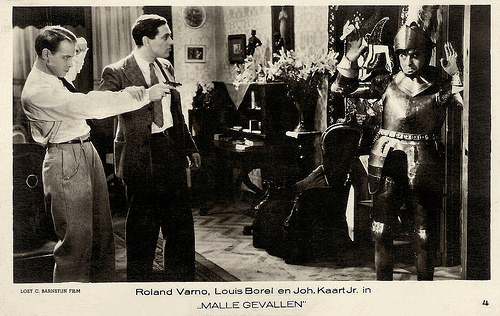
Dutch postcard by M.B.& Z. (M. Bonnist & Zonen, Amsterdam), no. 4. Photo: Loet C. Barnstijn Film. Still for Malle gevallen/Silly Situations (1934) with Roland Varno and Johan Kaart .
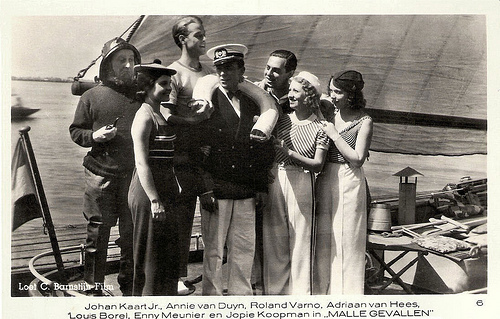
Dutch postcard by M.B.& Z. (M. Bonnist & Zonen, Amsterdam), no. 6. Photo: Loet C. Barnstijn Film. Still for Malle gevallen/Silly Situations (1934).
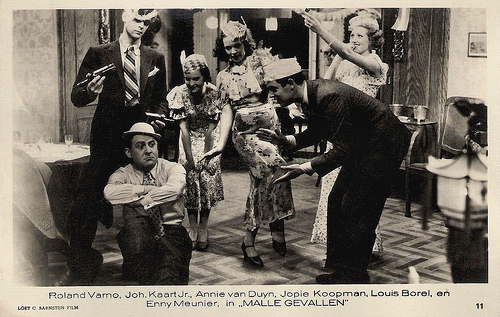
Dutch postcard by Loet C. Barnstijn Film, no. 11. Photo: still for Malle Gevallen/Silly Situations (1934). Collection: Geoffrey Donaldson Institute.
Hollywood
Louis Borel stayed in the US for ten years. First he appeared in small roles in Hollywood productions like Foreign correspondent (Alfred Hitchcock, 1940) and the anti-Nazi film Paris After Dark (Léonide Moguy, 1943).
Billed as Louis Borell, he had bigger roles in B-films like London Blackout Murders (George Sherman, 1943) and A Night of Adventure (Gordon Douglas, 1944). He also played several stage roles, including in Candle in the Wind and Made in Heaven.
In 1949 Louis Borel returned to the Netherlands, but regularly appeared in American TV shows like Passport to Danger, Crusader, Topper, and Those Whiting girls. He also played bit parts in the films Desirée (Henry Koster, 1954) with Marlon Brando , and The Purple Mask (H. Bruce Humerstone, 1955) starring Tony Curtis.
In The Netherlands he often worked as a stage director, and in 1955 he had his own company De Blijspelers. He also translated and adapted many plays. He appeared in the Dutch crime films 10.32/Murder in Amsterdam (Arthur Dreifuss, 1966) starring Linda Christian , and Because of the Cats (Fons Rademakers, 1973) with Bryan Marshall and Sylvia Kristel .
At the end of his career he became a popular TV star in the Netherlands for his role as the mayor in the legendary Dutch TV series Swiebertje (1970-1972) starring Joop Doderer as the tramp Swiebertje. Other TV series in which he appeared were Een Koekoek op het nest/The Cuckoo’s Nest (1965-1966), De Klop op de Deur/The Knock on the Door (1970-1971), and the children’s series De Vloek van Woestewolf/The Curse of Woestewolf (1973-1974).
Louis Borel died in 1973 in Amsterdam. In his last years he had suffered from Parkinson's and he was unable to control his mouth muscles. His last role had been in the TV play Hier stierf Anna Tholen/Here Died Anna Tholen, which was broadcasted posthumously. Borel was married to Jantje Stanneveld and they had a daughter, Fernanda Borel.
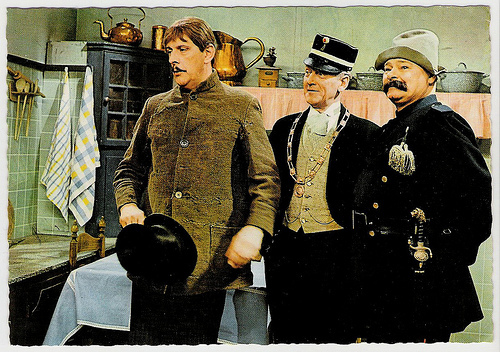
Dutch postcard. Photo: Joop Doderer, Rien van Nunen (who replaced Borel after his death as the mayor) and Lou Geels in Swiebertje.
Scene from Head Over Heels (1937) with Jessie Matthews . Source: guggle 86 (YouTube).
Sources: Wikipedia (Dutch), My Heritage, Swiebertje.tv (Dutch) and .

Dutch postcard by M. B.& Z. (M. Bonnist & Zonen, Amsterdam), no. 5. Photo: Loet C. Barnstijn Film. Still for Malle gevallen/Silly Situations (Jaap Speyer, 1934) with Jopie Koopman .

Dutch postcard by Loet C. Barnstijn Film, no. 2. Photo: still for Malle Gevallen/Silly Situations (1934). Collectie: Geoffrey Donaldson Institute.
Silly Situations
Louis Borel was born as Lodewijk Borel in Den Haag (The Hague), Netherlands in 1905. He was the son of author and journalist Henri Jean François Borel and his second wife Helena Maria de Hartog. He had two half-sisters and a half-brother. His father had destined Louis to become a banker but the boy chose otherwise.
In 1924, Louis started his stage career as Lodewijk Makkay at the company of legendary Dutch actor Cor van der Lugt Melsert. Next he worked at the Nederlands-Indisch Toneel (Dutch-Indonesian Theatre), led by Cor Ruys, which performed alternately in the Netherlands and the Dutch East Indies. In 1928 he worked with a theatre group which was led by Theo Frenkel jr.
In 1934 he made his film debut in the comedy Malle gevallen/Silly Situations (Jaap Speyer, 1934) based on a novel by Hans Martin. Louis played Hans, one of three students (the others were Johan Kaart and Roland Varno ) who date three nice girls ( Annie van Duyn , Enny Meunier and Jopie Koopman ).
In a row he made three more films. De Kribbebijter/The Cross-Patch (Hermann Kosterlitz aka Henry Koster, Ernst Winar, 1935) was a comedy starring Cor Ruys and Frits van Dongen (aka Philip Dorn). In the comedy De Suikerfreule/The Sugar Lady (Haro van Peski, 1935) starred Johan Elsensohn and Annie van Duyn . Fientje Peters - Poste restante/Fientje Peters: General Delivery (Victor Janson, 1935) with Dolly Bouwmeester was an alternate language version of the German production Hilde Petersen postlagernd (Victor Janson, 1936).
At the end of 1934 Borel moved to England, where he worked on stage and in the cinema till 1939. He was successful in the play Return to yesterday and was praised for his charm by the British critics. He also acted in the play Heart's Content, at the Shaftesbury Theatre in London, with Diana Wynyard , and Anthony Bushell in the cast. Raymond Massey was director.
British film productions in which he played leading roles were House Broken (Michael Hankinson, 1936), the crime film The Avenging Hand (Victor Hanbury, Frank Richardson, 1937) with Noah Beery, the musical Head Over Heels (Sonnie Hale, 1937) opposite Jessie Matthews , and the Alexander Korda produced comedy Over the Moon (Thornton Freeland, 1939) with Rex Harrison and Merle Oberon .
Borel returned shortly to the Netherlands, where he starred in De Spooktrein/The Ghosttrain (Karel Lamac aka Carl Lamac, 1939) with Jan Musch and Fien de la Mar . Then he left for the United States.

Dutch postcard by M.B.& Z. (M. Bonnist & Zonen, Amsterdam), no. 4. Photo: Loet C. Barnstijn Film. Still for Malle gevallen/Silly Situations (1934) with Roland Varno and Johan Kaart .

Dutch postcard by M.B.& Z. (M. Bonnist & Zonen, Amsterdam), no. 6. Photo: Loet C. Barnstijn Film. Still for Malle gevallen/Silly Situations (1934).

Dutch postcard by Loet C. Barnstijn Film, no. 11. Photo: still for Malle Gevallen/Silly Situations (1934). Collection: Geoffrey Donaldson Institute.
Hollywood
Louis Borel stayed in the US for ten years. First he appeared in small roles in Hollywood productions like Foreign correspondent (Alfred Hitchcock, 1940) and the anti-Nazi film Paris After Dark (Léonide Moguy, 1943).
Billed as Louis Borell, he had bigger roles in B-films like London Blackout Murders (George Sherman, 1943) and A Night of Adventure (Gordon Douglas, 1944). He also played several stage roles, including in Candle in the Wind and Made in Heaven.
In 1949 Louis Borel returned to the Netherlands, but regularly appeared in American TV shows like Passport to Danger, Crusader, Topper, and Those Whiting girls. He also played bit parts in the films Desirée (Henry Koster, 1954) with Marlon Brando , and The Purple Mask (H. Bruce Humerstone, 1955) starring Tony Curtis.
In The Netherlands he often worked as a stage director, and in 1955 he had his own company De Blijspelers. He also translated and adapted many plays. He appeared in the Dutch crime films 10.32/Murder in Amsterdam (Arthur Dreifuss, 1966) starring Linda Christian , and Because of the Cats (Fons Rademakers, 1973) with Bryan Marshall and Sylvia Kristel .
At the end of his career he became a popular TV star in the Netherlands for his role as the mayor in the legendary Dutch TV series Swiebertje (1970-1972) starring Joop Doderer as the tramp Swiebertje. Other TV series in which he appeared were Een Koekoek op het nest/The Cuckoo’s Nest (1965-1966), De Klop op de Deur/The Knock on the Door (1970-1971), and the children’s series De Vloek van Woestewolf/The Curse of Woestewolf (1973-1974).
Louis Borel died in 1973 in Amsterdam. In his last years he had suffered from Parkinson's and he was unable to control his mouth muscles. His last role had been in the TV play Hier stierf Anna Tholen/Here Died Anna Tholen, which was broadcasted posthumously. Borel was married to Jantje Stanneveld and they had a daughter, Fernanda Borel.

Dutch postcard. Photo: Joop Doderer, Rien van Nunen (who replaced Borel after his death as the mayor) and Lou Geels in Swiebertje.
Scene from Head Over Heels (1937) with Jessie Matthews . Source: guggle 86 (YouTube).
Sources: Wikipedia (Dutch), My Heritage, Swiebertje.tv (Dutch) and .
Published on September 21, 2016 22:00
Paul van Yperen's Blog
- Paul van Yperen's profile
- 13 followers
Paul van Yperen isn't a Goodreads Author
(yet),
but they
do have a blog,
so here are some recent posts imported from
their feed.



